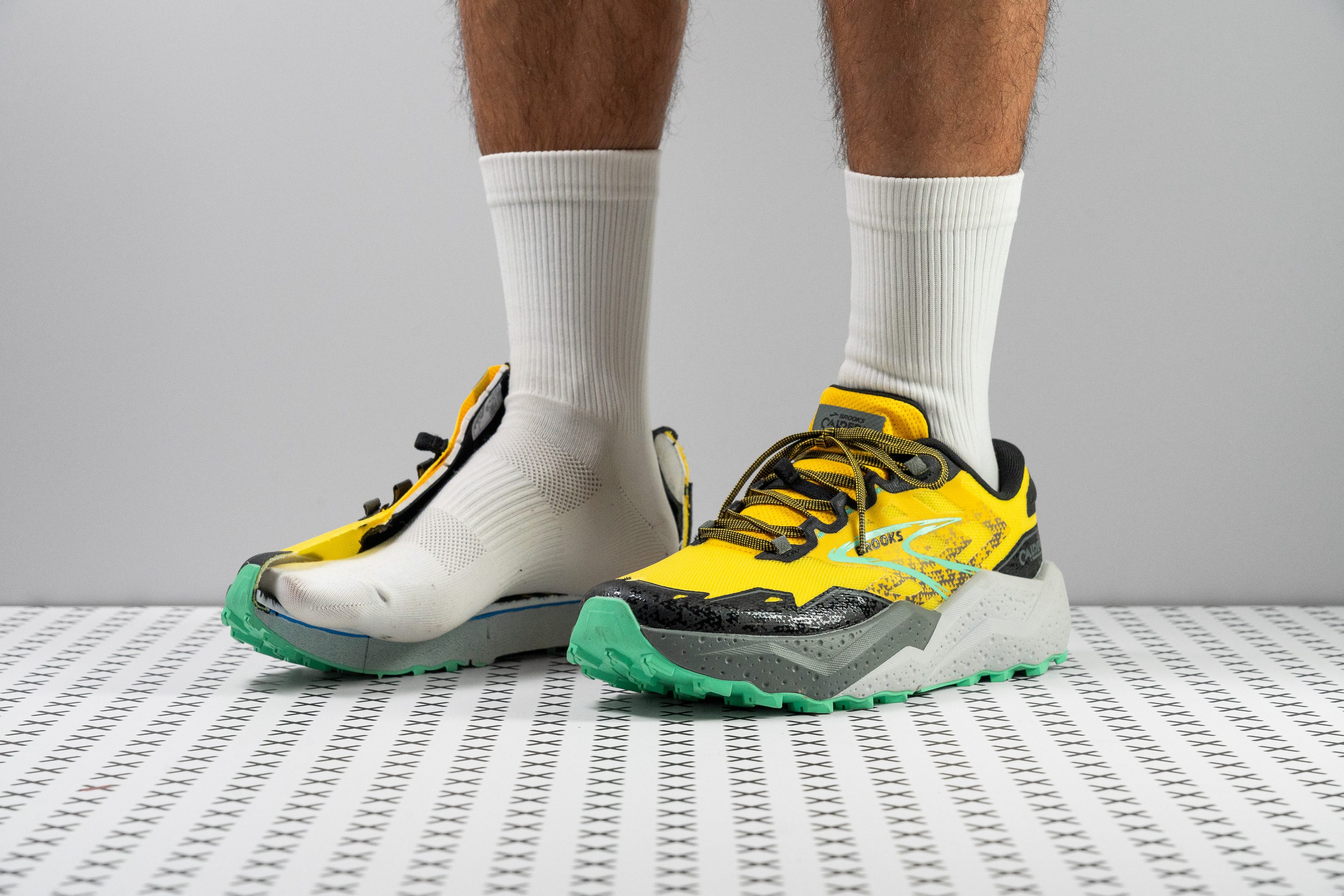Our verdict
Pros
- Tonnes of cushioning
- Plush DNA Loft v3 foam
- Best Caldera to date
- Superb upper ventilation
- Surprisingly stable
- Fairly priced
- Can handle ultra races
Cons
- Still heavy
- Outsole could be better
- Not for technical trails
Audience verdict
Comparison
The most similar running shoes compared
+ + Add a shoe | |||||
|---|---|---|---|---|---|
| Audience score | 88 Great! | 89 Great! | 81 Good! | 88 Great! | |
| Price | £150 | £140 | £80 | £160 | |
| Trail terrain | LightModerate | LightModerate | Light | ModerateTechnical | |
| Shock absorption | High | Moderate | Moderate | Moderate | |
| Energy return | Moderate | Moderate | Low | Moderate | |
| Traction | - | High | - | - | |
| Arch support | Neutral | Neutral | Neutral | Neutral | |
| Weight lab Weight brand | 10.8 oz / 305g 10.6 oz / 300g | 10.9 oz / 309g 10.9 oz / 309g | 10.3 oz / 292g 10.4 oz / 296g | 10.3 oz / 293g 10.4 oz / 295g | |
| Drop lab Drop brand | 8.9 mm 6.0 mm | 8.8 mm 6.0 mm | 10.1 mm 8.0 mm | 7.2 mm 4.0 mm | |
| Strike pattern | HeelMid/forefoot | HeelMid/forefoot | Heel | Mid/forefoot | |
| Size | True to size | True to size | True to size | True to size | |
| Midsole softness | Soft | Soft | Balanced | Soft | |
| Difference in midsole softness in cold | Small | Big | Normal | Normal | |
| Toebox durability | Decent | Bad | Very bad | Good | |
| Heel padding durability | Good | Good | Bad | Good | |
| Outsole durability | Decent | Decent | Decent | Good | |
| Breathability | Breathable | Moderate | Moderate | Moderate | |
| Width / fit | Medium | Medium | Medium | Medium | |
| Toebox width | Medium | Medium | Medium | Narrow | |
| Stiffness | Stiff | Moderate | Flexible | Moderate | |
| Torsional rigidity | Stiff | Stiff | Stiff | Stiff | |
| Heel counter stiffness | Stiff | Stiff | Stiff | Flexible | |
| Lug depth | 4.0 mm | 3.6 mm | 4.0 mm | 3.9 mm | |
| Heel stack lab Heel stack brand | 36.7 mm 39.0 mm | 36.7 mm 39.0 mm | 37.7 mm 36.0 mm | 38.0 mm 33.0 mm | |
| Forefoot lab Forefoot brand | 27.8 mm 33.0 mm | 27.9 mm 33.0 mm | 27.6 mm 28.0 mm | 30.8 mm 29.0 mm | |
| Widths available | Normal | Normal | Normal | Normal | |
| For heavy runners | ✗ | ✗ | ✓ | ✗ | |
| Season | SummerAll seasons | All seasons | All seasons | All seasons | |
| Removable insole | ✓ | ✓ | ✓ | ✓ | |
| Orthotic friendly | ✓ | ✓ | ✓ | ✓ | |
| Ranking | #262 Top 40% | #87 Top 24% | #296 Bottom 20% | #131 Top 36% | |
| Popularity | #417 Bottom 36% | #173 Top 47% | #205 Bottom 44% | #103 Top 28% |
Who should buy
We think the Caldera 7 is a superb choice for:
- Runners who cherish the plush ride of Brooks' road shoes with DNA Loft v3 and want a trail option for easy adventures.
- Those new to trail running that want a superbly cushioned shoe.
- Maximalist shoe fans exploring new alternatives beyond Hokas that seek a stable ride.
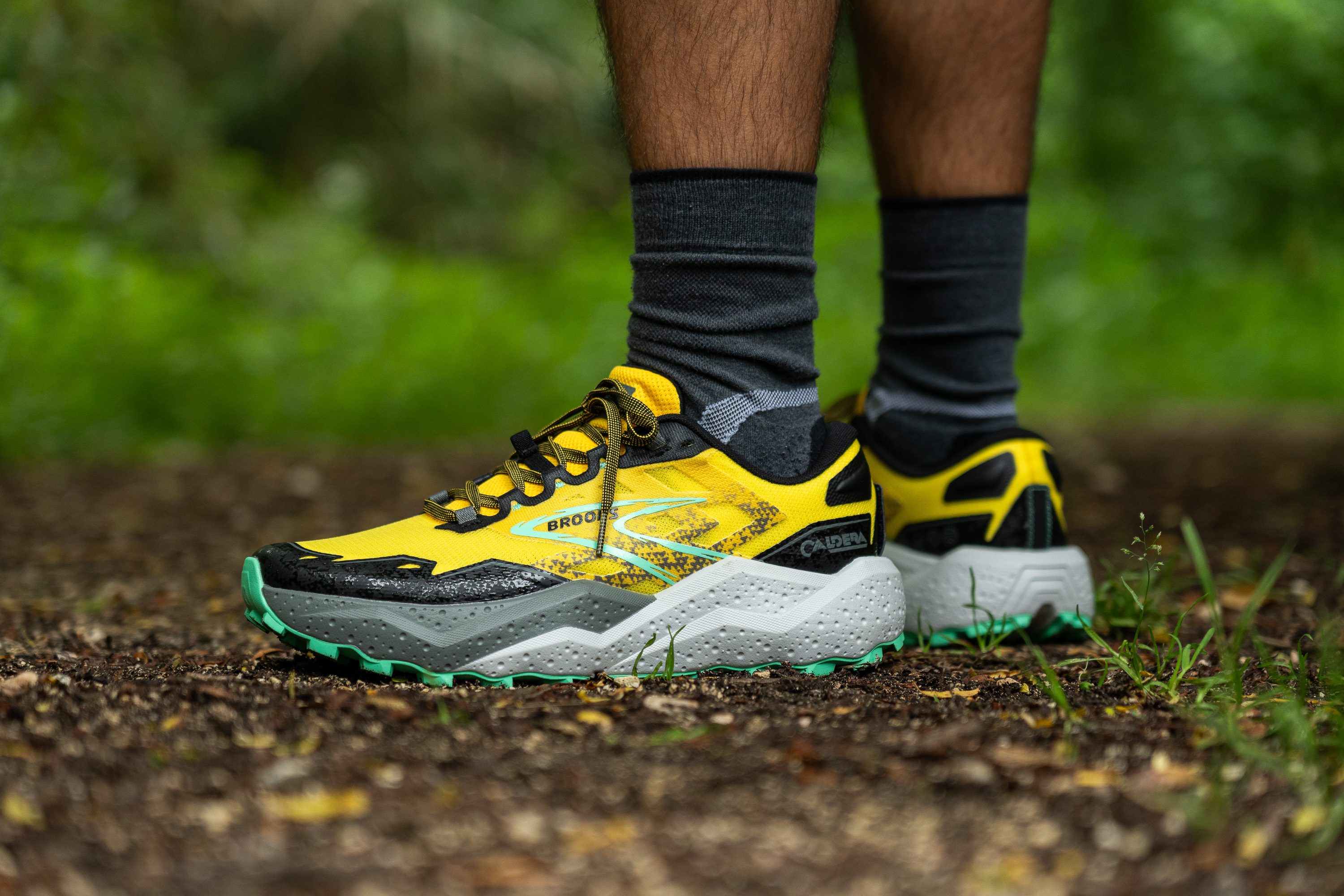
Who should NOT buy
With such a soft and thick midsole, we observed that the immediate feedback from the ground is just missing. It's designed to prioritise comfort above all else, which we think might not suit everyone's taste. Those who favour a firmer midsole would do better in the Brooks Divide 4 or the Altra Outroad.
We also think that those who prefer lightweight shoes won't find a pleasant experience with the Cascadia 7. However, we have tested a fantastic alternative that also boasts a good chunk of foam but in a lighter build—the Hoka Mafate Speed 4.
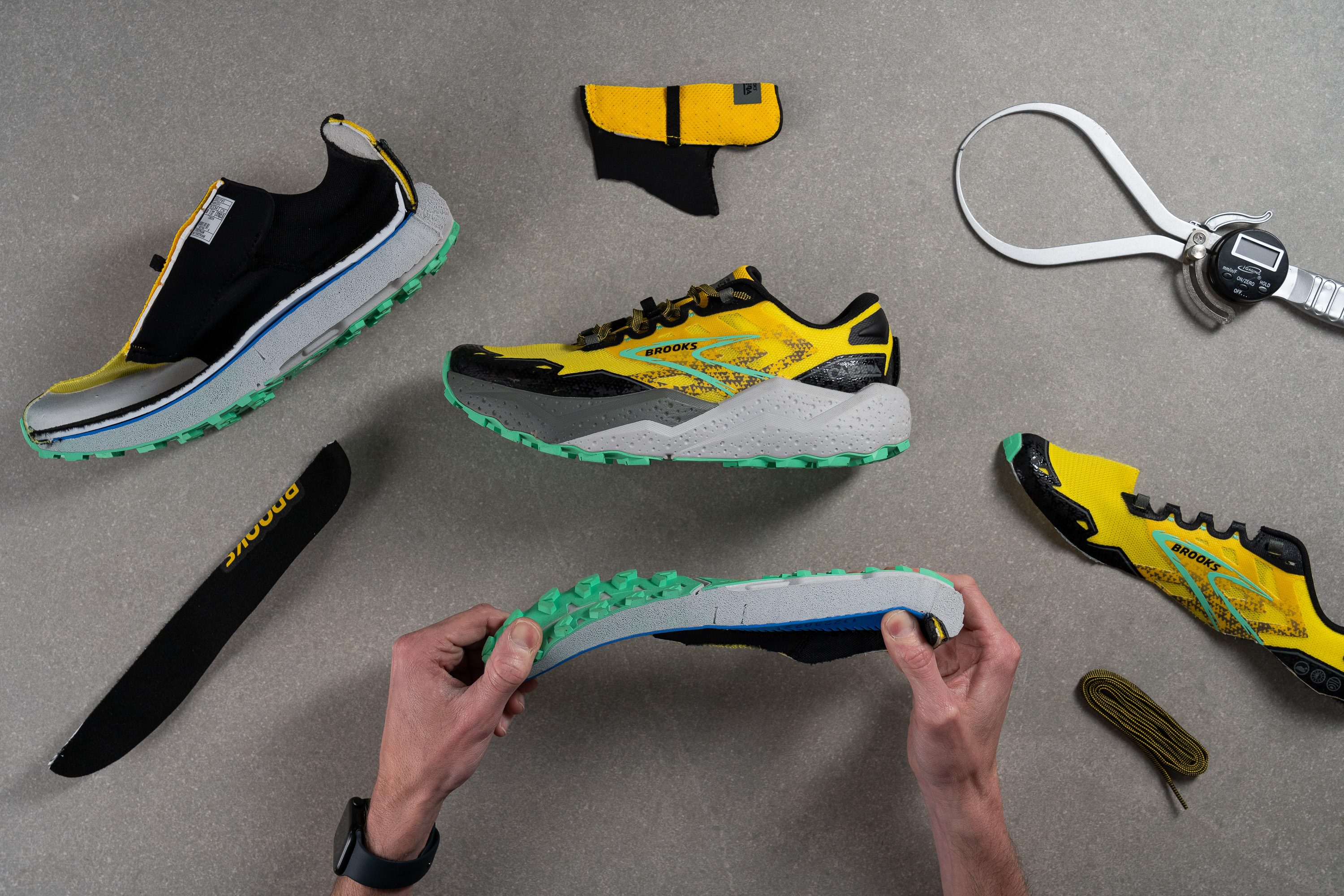
Cushioning
Shock absorption
We were eager to test the shock absorption in the Caldera 7 thanks to its thick midsole, and it didn’t disappoint. Quite the opposite, it proved ready for endless cushioning with a plush 135 SA in our lab test.
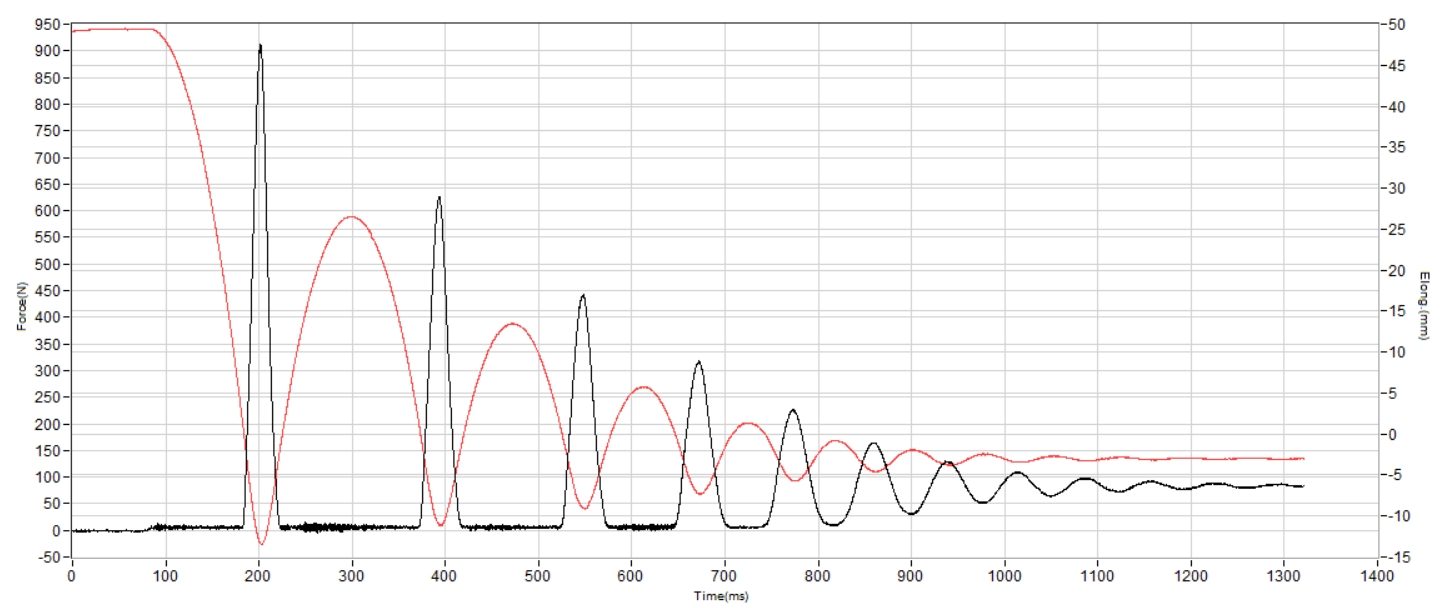
| Caldera 7 | 135 SA |
| Average | 122 SA |
Energy return
Energy return is solid too, with 59.6% in the heel and 60.1% in the forefoot. These are strong numbers that position the Caldera 7 as a solid pick for ultra distances, where above-average cushioning and rebound really matter.
| Caldera 7 | 59.6% |
| Average | 55.6% |
Heel stack
At first glance, the Caldera 7 unmistakably features a maximalist design, focusing on a thick midsole above all. However, in our lab, we don't just rely on appearances; we measure. Using digital callipers, we determined a substantial heel stack height of 36.7 mm.
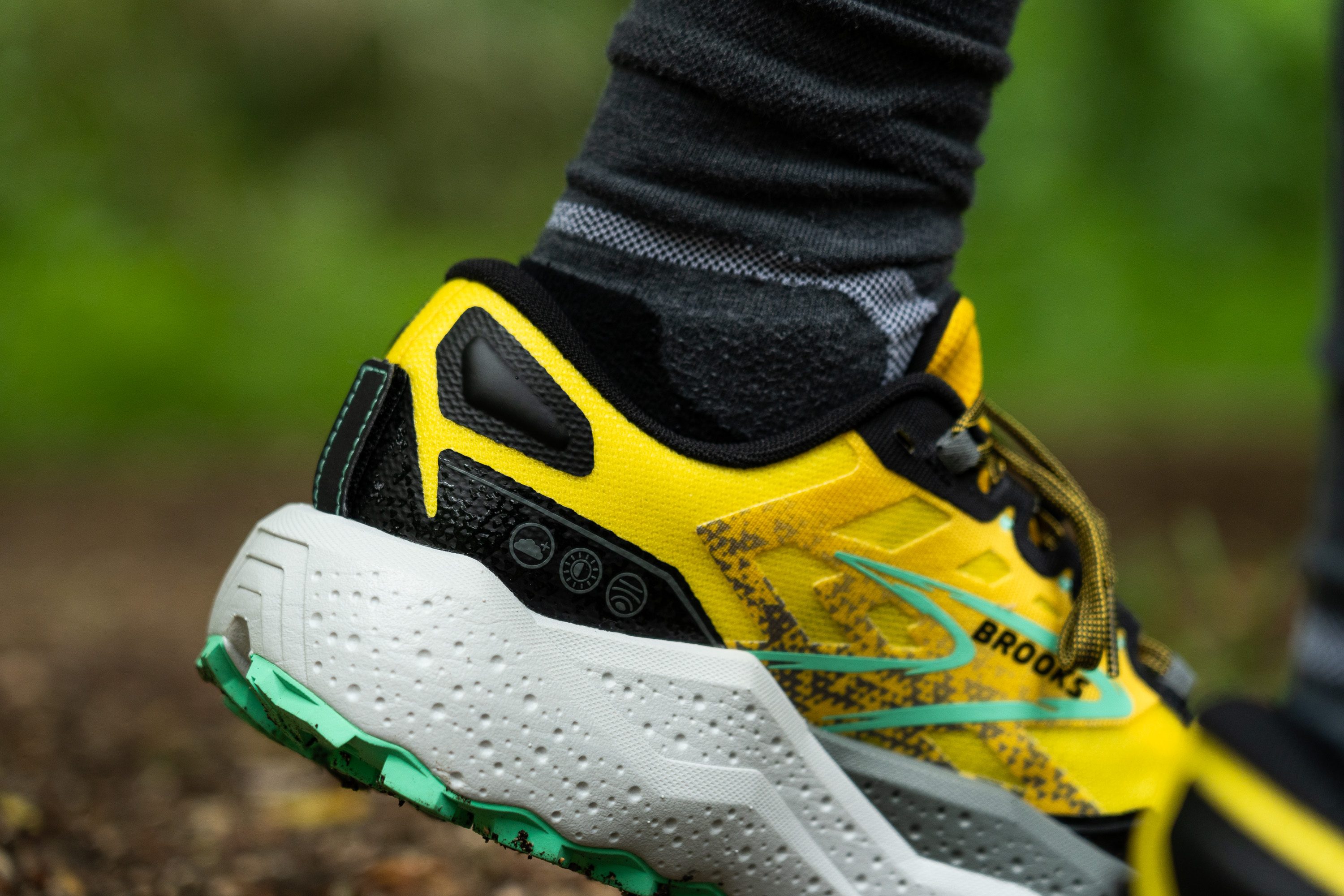
This significant measurement is especially appealing for heavy heel strikers looking for a durable, leg-friendly trail runner. We guarantee that this kind of cushioning absorbs impacts effectively, making long runs less taxing on the legs.
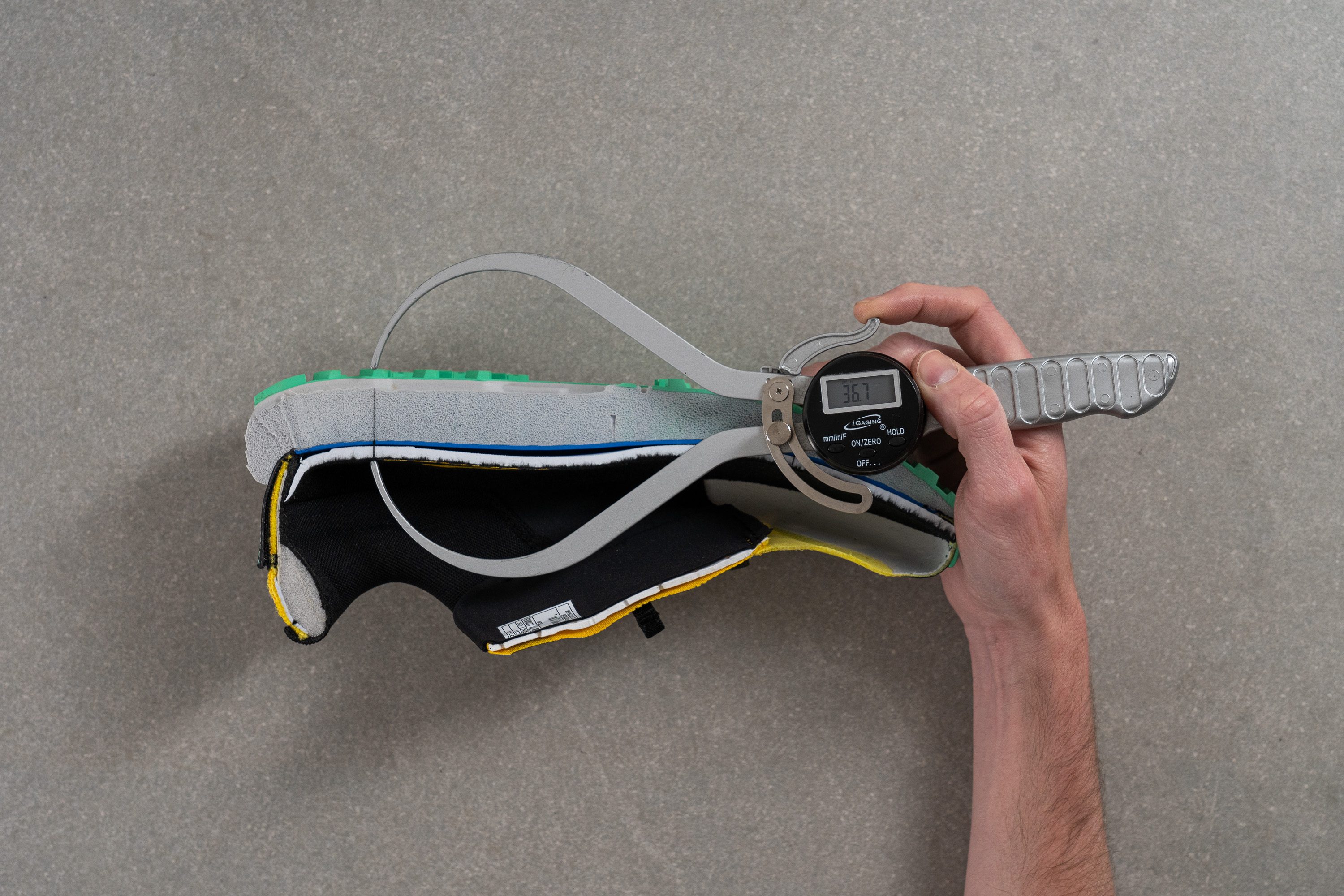
| Caldera 7 | 36.7 mm |
| Average | 32.6 mm |
Forefoot stack
The forefoot height of the Caldera 7 dips below 30 millimetres, measuring just 27.8 mm.
This lower profile offers a grounded feel for forefoot strikers, ensuring the shoe doesn’t feel overly tall during runs as it does with heel strikers.
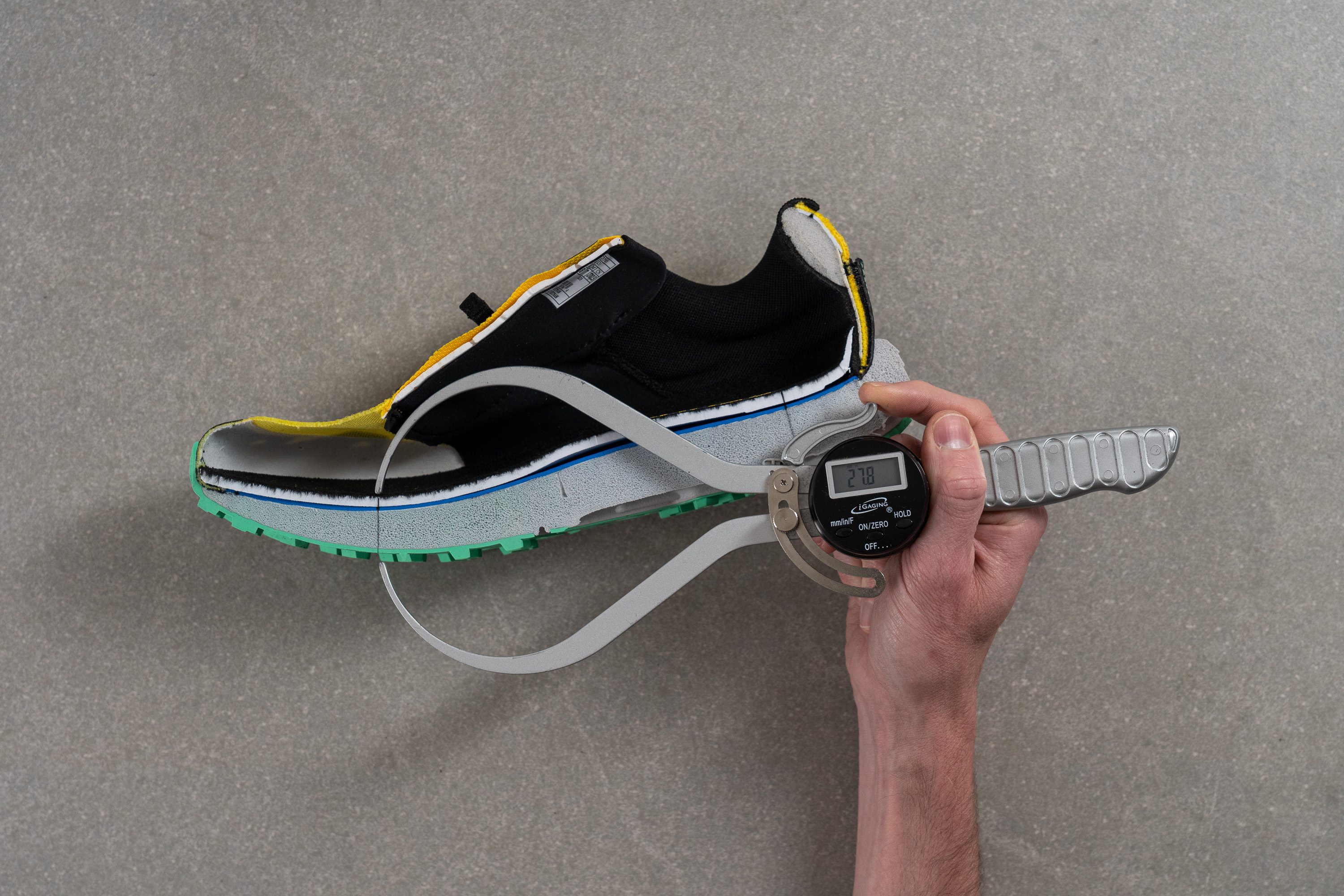
| Caldera 7 | 27.8 mm |
| Average | 25.1 mm |
Drop
The Caldera 7 features an 8.9-mm heel-to-toe drop, ideally suited for rearfoot strikers, though it accommodates all types of footstrikes with ease.
It's important to mention that Brooks advertises a 6-mm drop, so runners expecting a mid-drop feel might notice a slight difference in the shoe's feel.
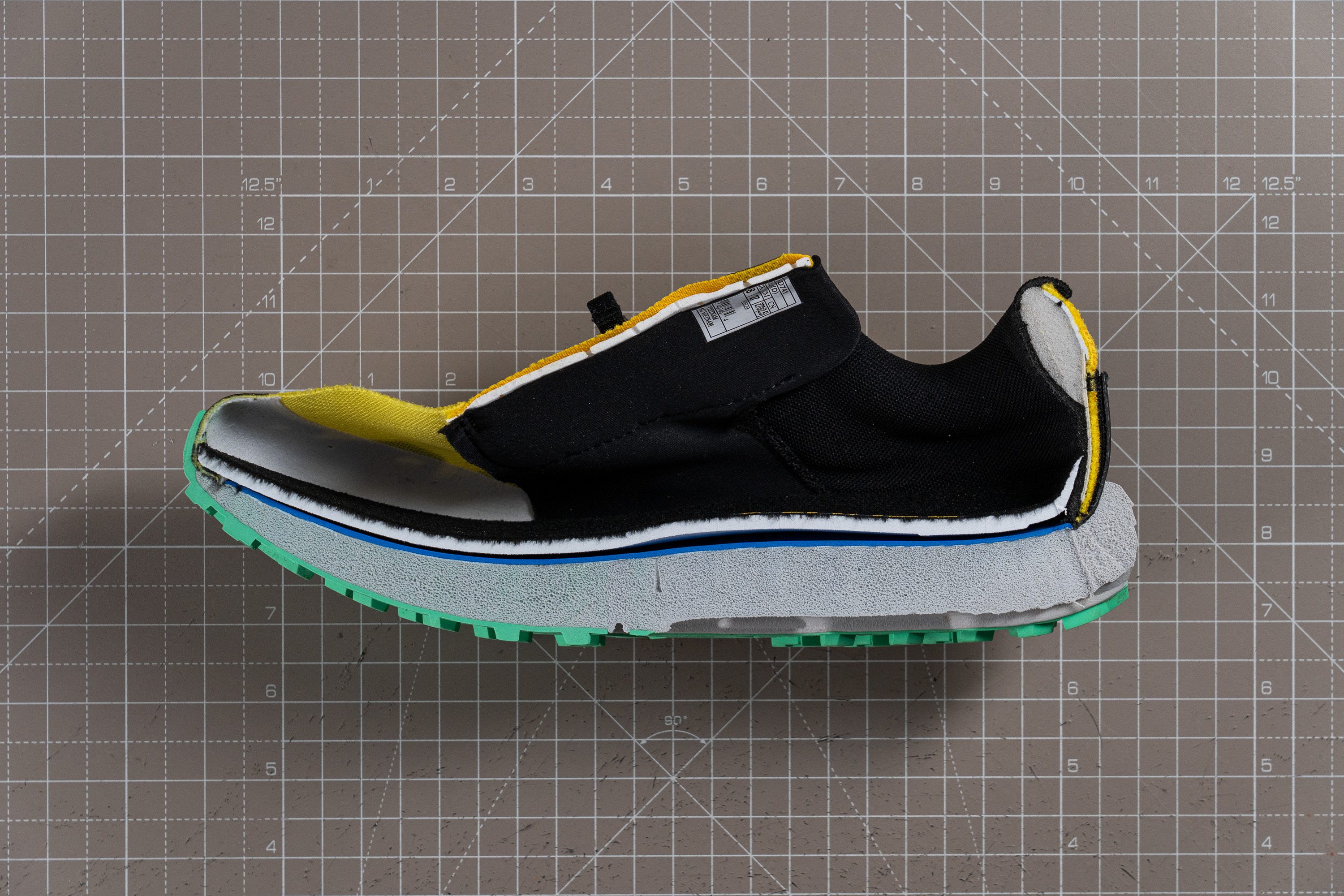
| Caldera 7 | 8.9 mm |
| Average | 7.6 mm |
Midsole softness
We've delved deeply into the Caldera's cushioning and discovered its core—DNA Loft v3, an EVA-based foam that's infused with nitrogen.
This supercritical formula delivers a remarkable bounce while maintaining an ultra-plush sensation, which we quantified at a soft 15.5 HA on our durometer, notably soft for a trail shoe.
This plushness steers the shoe toward long distances and gentler trails. With such a soft and thick midsole, we observed that the immediate feedback found in firmer soles is missing—it's designed to prioritise comfort above all else, which we think might not suit everyone's taste.
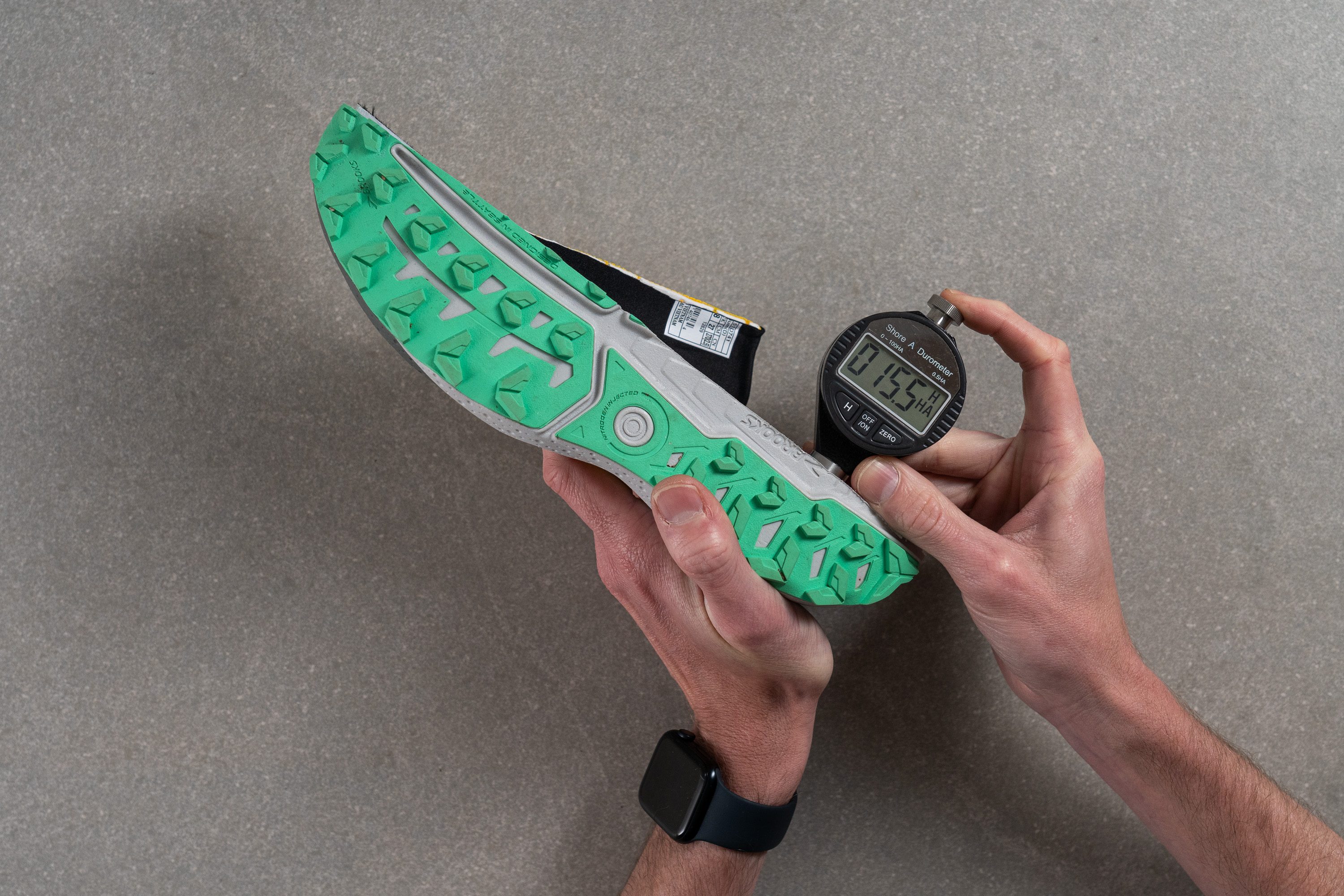
| Caldera 7 | 15.5 HA |
| Average | 21.9 HA |
Rocker
The Caldera 7 incorporates a subtle toe rocker—though it's not very pronounced, it feels less significant during a run than it appears, as the midfoot and heel remain mostly flat, and there's virtually no heel bevel at all.
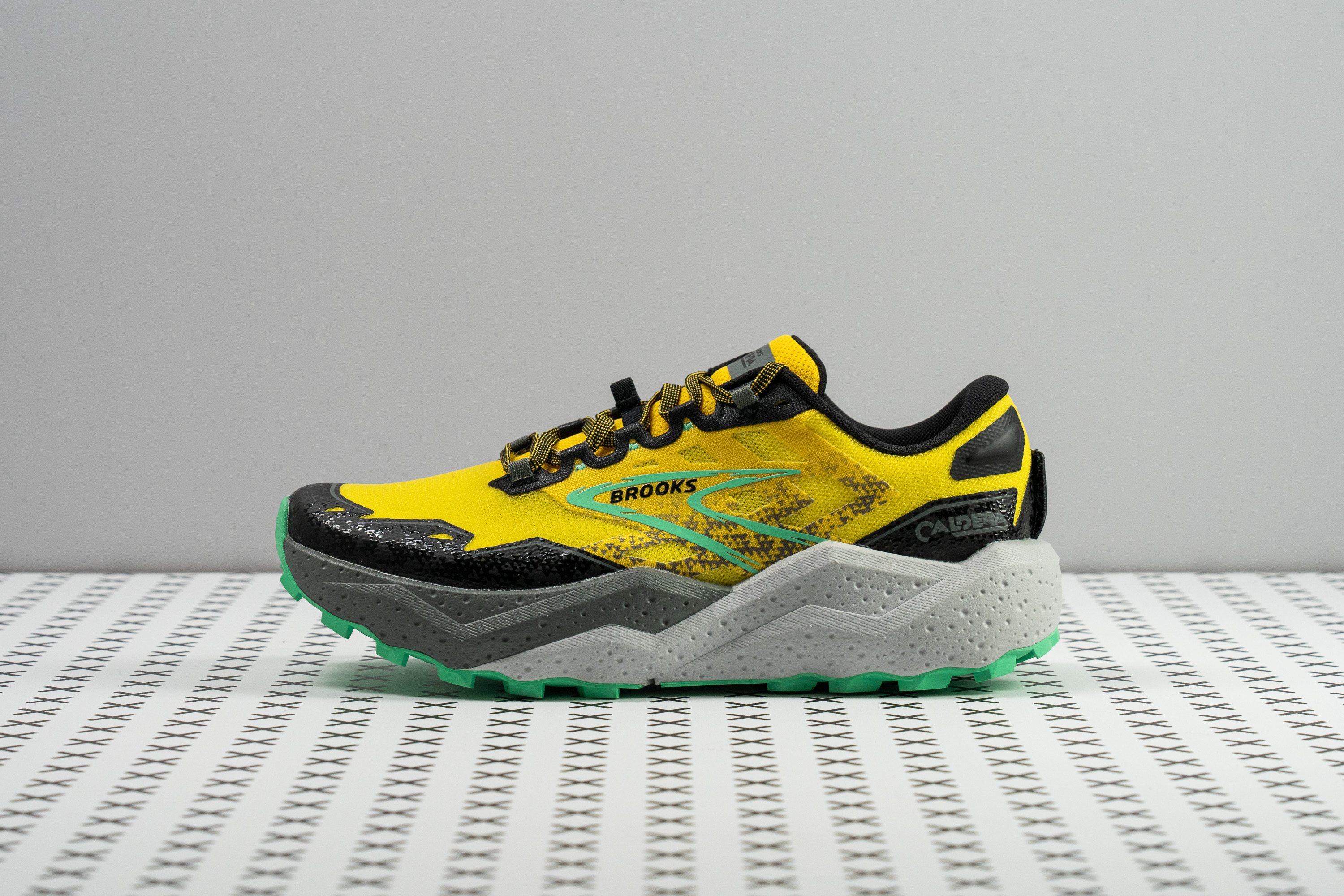
Size and fit
Size
Brooks Caldera 7 fits true to size (110 votes).
Width / Fit
We made a custom gel mould and used our digital callipers to measure a critical aspect of any running shoe—the width.
Our initial measurement gave us 95.5 mm across the widest part of the upper, confirming our impression that this version of the Caldera is the broadest and most spacious yet, but it's still an average running shoe. However, we'll reserve our final judgement until after our second evaluation.
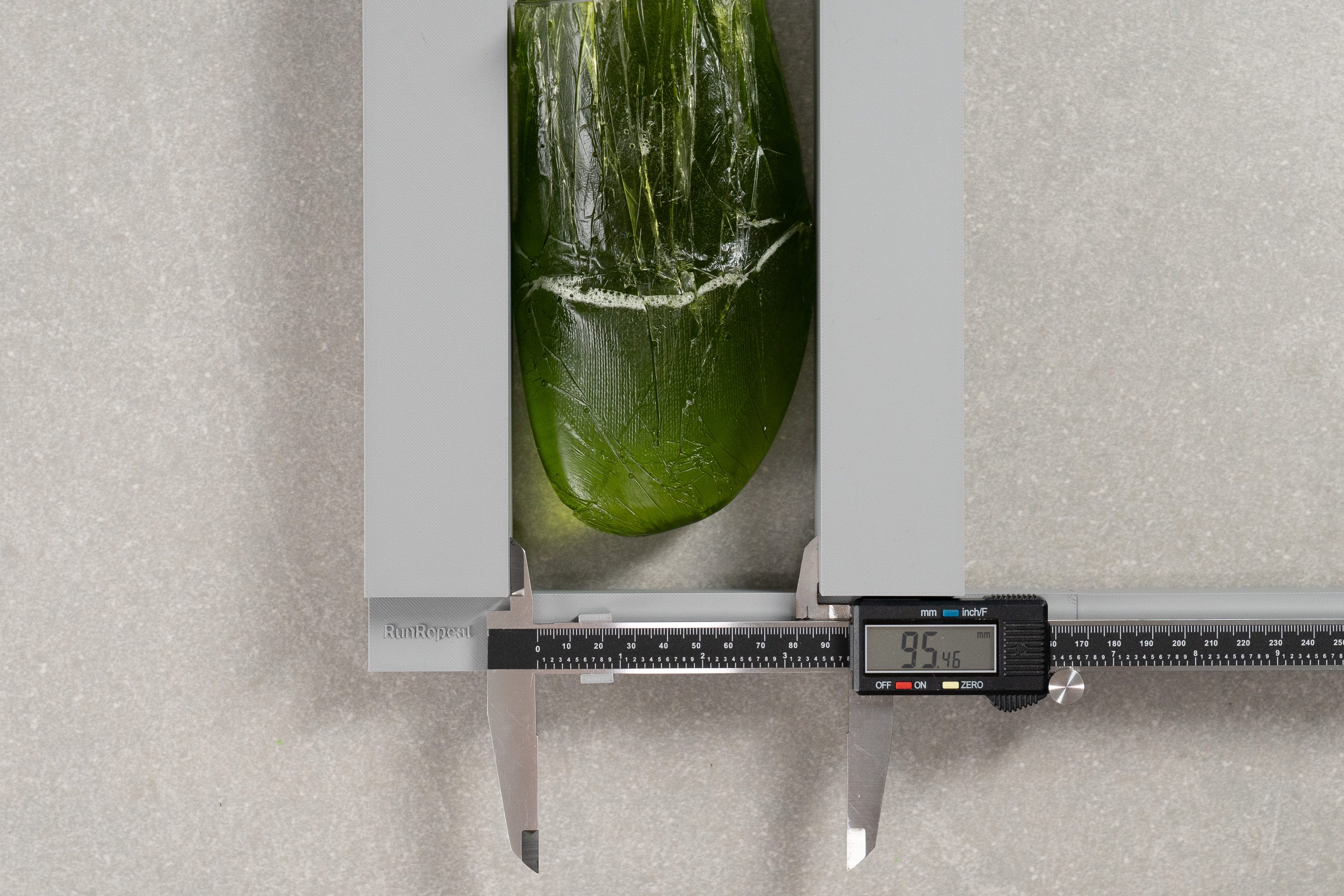
| Caldera 7 | 95.5 mm |
| Average | 95.6 mm |
Toebox width
Brooks has noticeably widened the upper around the big toe area to 73.9 mm, resulting in a less tapered toebox.
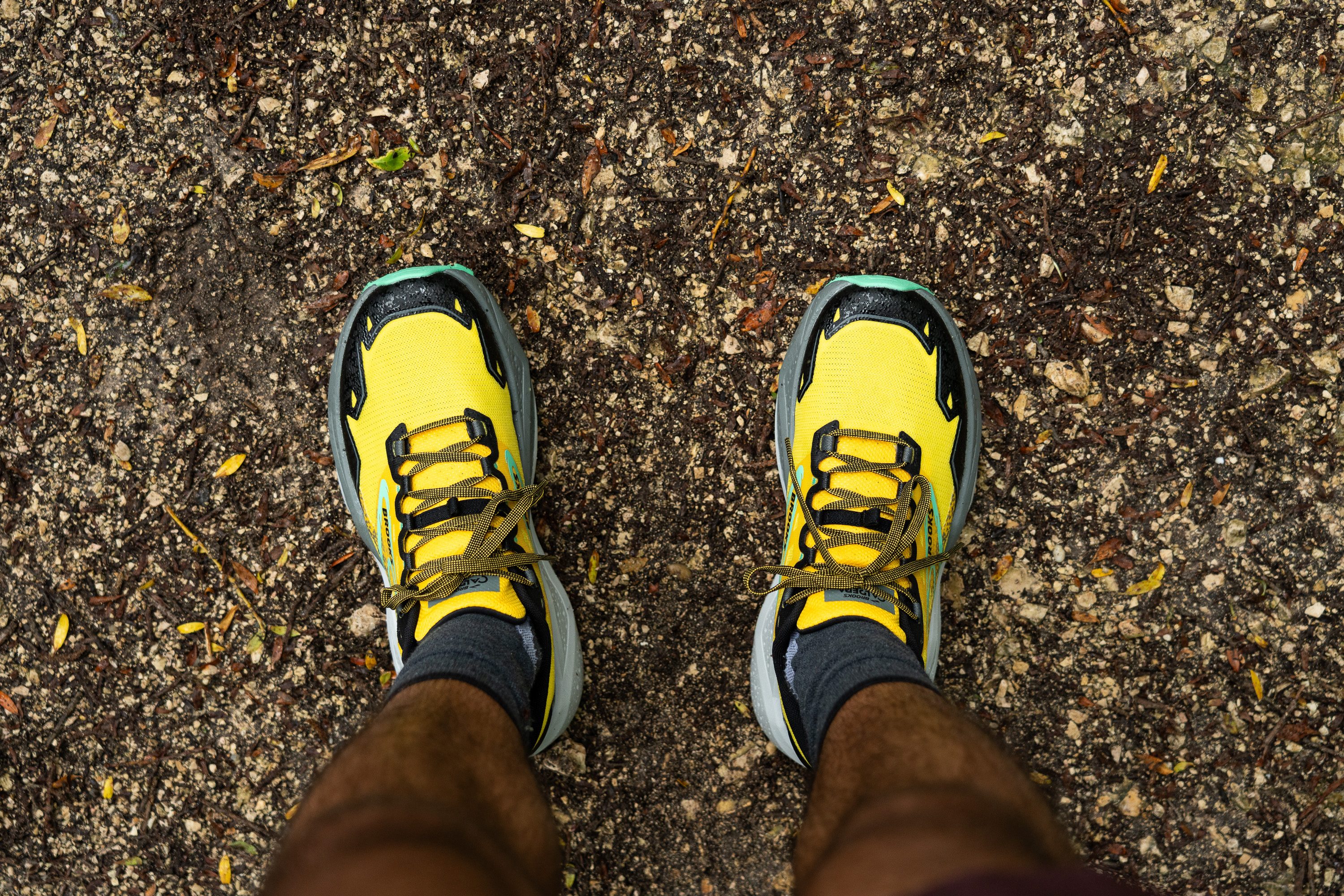
However, similar to our first measurement, this remains close to average—wider than ever for a Caldera but still best suited for narrow to average feet.

| Caldera 7 | 73.9 mm |
| Average | 74.6 mm |
Toebox height
Runners with high-volume feet or those who often experience toe pressure in most shoes should avoid the Caldera 7. At just 25.0 mm, the toebox offers minimal room for toe movement or wiggle space.
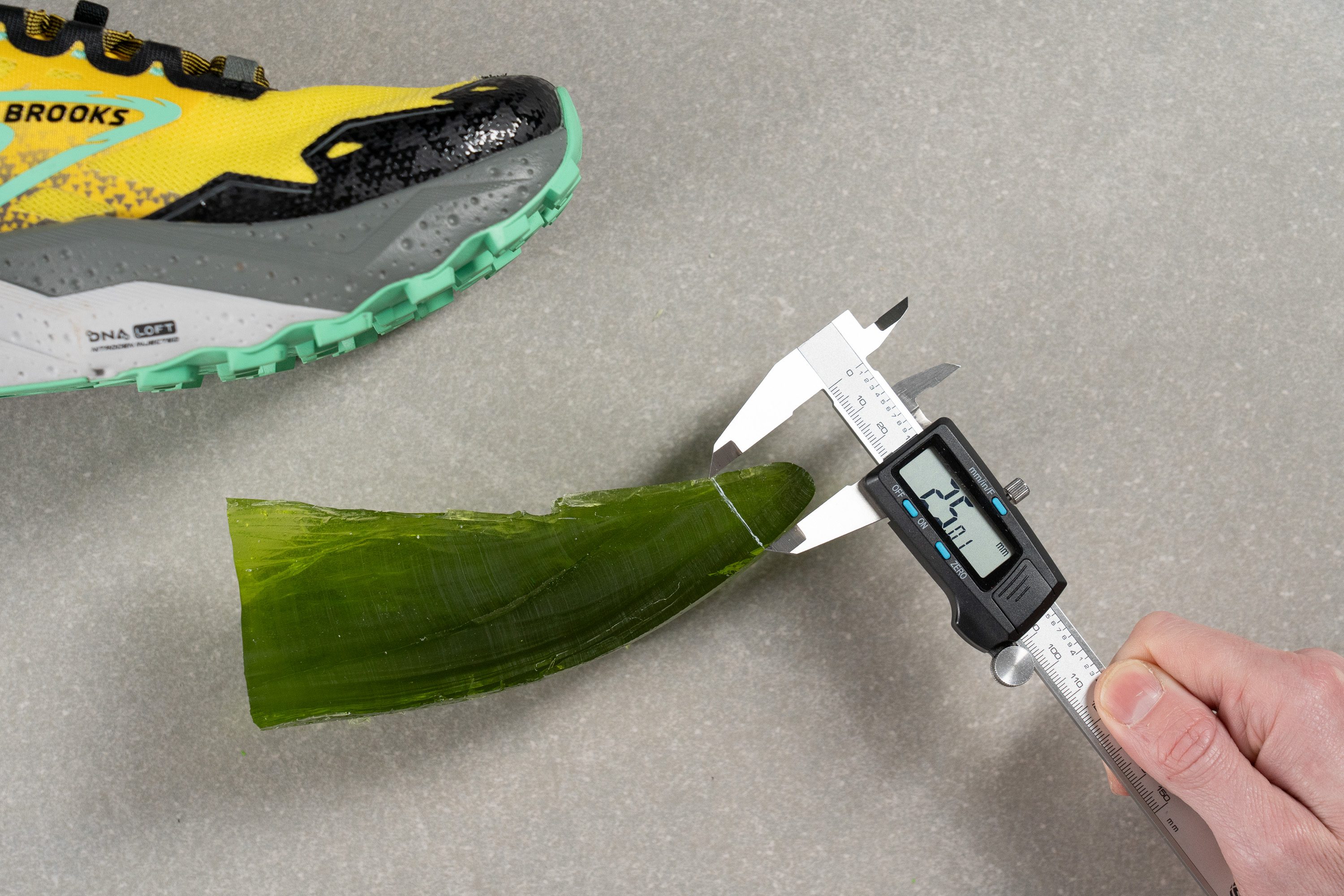
| Caldera 7 | 25.0 mm |
| Average | 27.0 mm |
Traction / Grip
Forefoot traction
The TrailTack Green Rubber compound delivered a very good performance in our traction test, scoring a strong 0.48—clearly outperforming most competitors. As a result, the Caldera 7 provides dependable grip in both dry and rain-soaked conditions.
| Caldera 7 | |
| Average | 0.60 |
Lug depth
Brooks has traditionally marketed the Caldera as a set-and-forget shoe ideal for easy trails, so we were somewhat surprised to discover 4.0-mm lugs, a slight increase from the 3.5-mm lugs on the Caldera 6.
Is this a beneficial change? It depends. While the deeper lugs add versatility for navigating more varied terrains and improve traction in wet conditions, we also believe they might reduce comfort on flat, easy trails. Indeed, trail running outsoles always involve trade-offs!
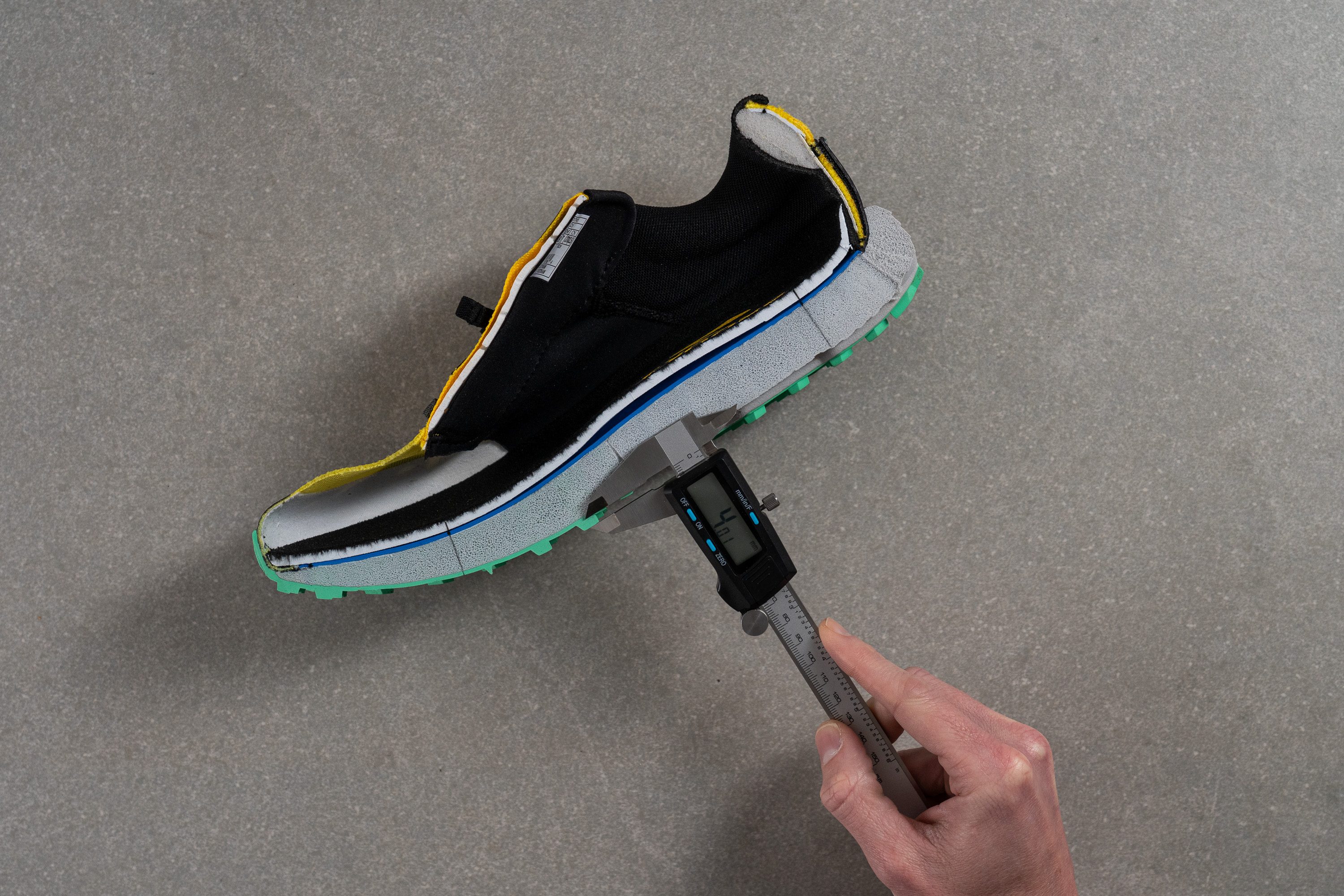
| Caldera 7 | 4.0 mm |
| Average | 3.5 mm |
Outsole design
The outsole boasts chevron-shaped lugs designed to enhance traction during descents and ascents. Additionally, we discovered a large central channel that significantly aids in flexibility and mud clearance.

Flexibility / Stiffness
The Caldera 7 demonstrated a moderate resistance for its high thickness, requiring 17.6N to achieve the desired 30-degree bend. This makes it a versatile trail shoe for both ultra runs and easy hikes.
| Caldera 7 | 17.6N |
| Average | 14.6N |
Stiffness in cold (%)
We placed the Caldera in the freezer for another 20 minutes and retested its stiffness. The result showed a 20.2% change, confirming that the shoe maintains its flexibility even in winter—an excellent feature that ensures it won’t stiffen up too much in chilly conditions.
| Caldera 7 | 20% |
| Average | 32% |
Weight
Speaking of the devil, the weight of the Caldera has always been a significant concern, as it tended to feel a bit heavy for everyone.
We were pleased to discover a slight reduction in weight with version 7, which now dips below the 11-oz mark to a more manageable 10.75 oz. But we want to see it reach 10 oz, come on Brooks!
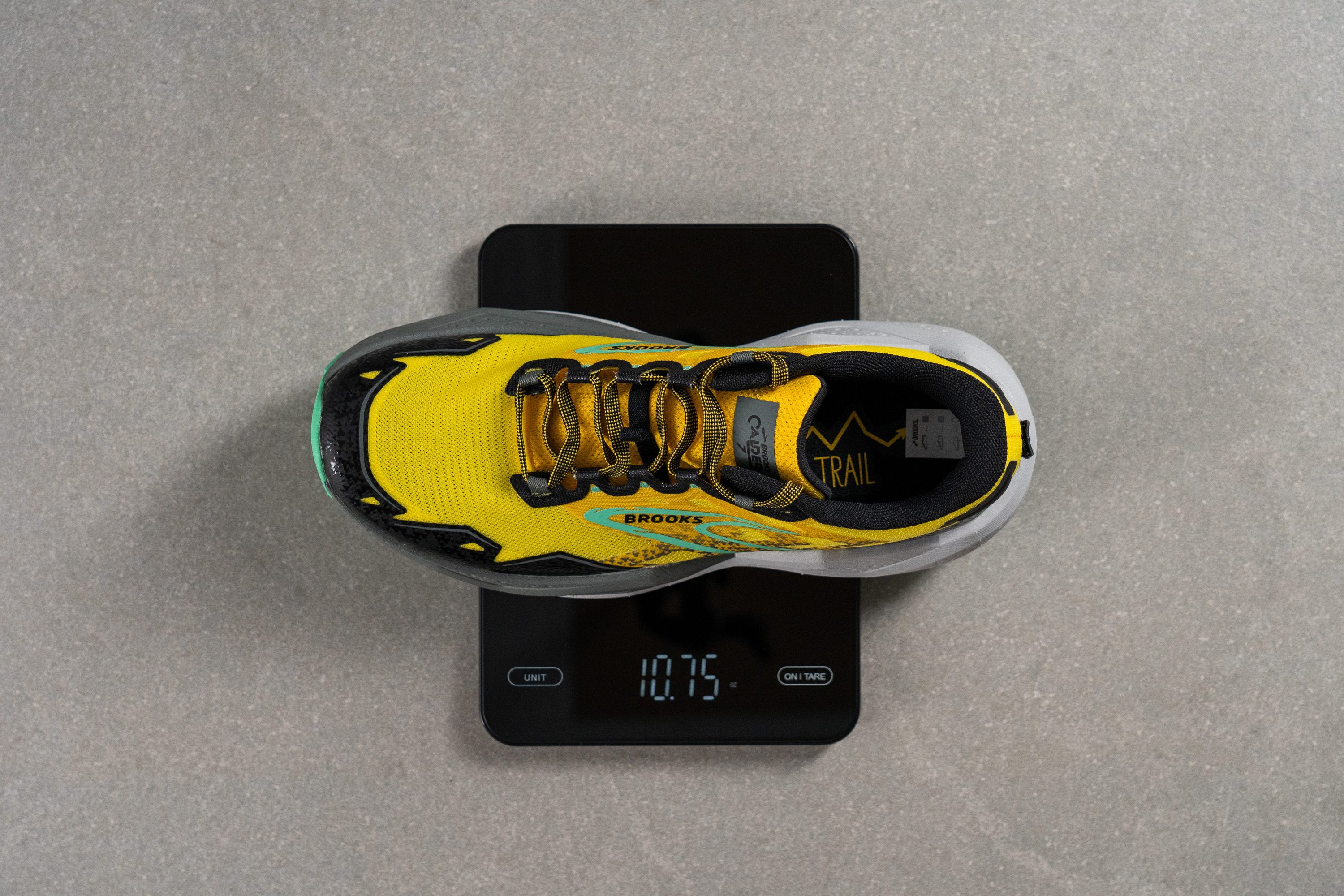
| Caldera 7 | 10.8 oz (305g) |
| Average | 10.2 oz (289g) |
Breathability
When it comes to trail shoes, breathability often takes a backseat, especially when compared to their road-running counterparts. Yet, the Caldera 7 shatters this expectation with outstanding ventilation.
Following our tests using a smoke-pumping machine, we awarded it a perfect score of 5/5, making it a top pick for warm weather trail adventures.
Curious about its superior airflow, we zoomed in on the construction and discovered that while the toebox boasts robust ventilation, the rest of the upper opts for a thicker, more structured build to enhance stability.
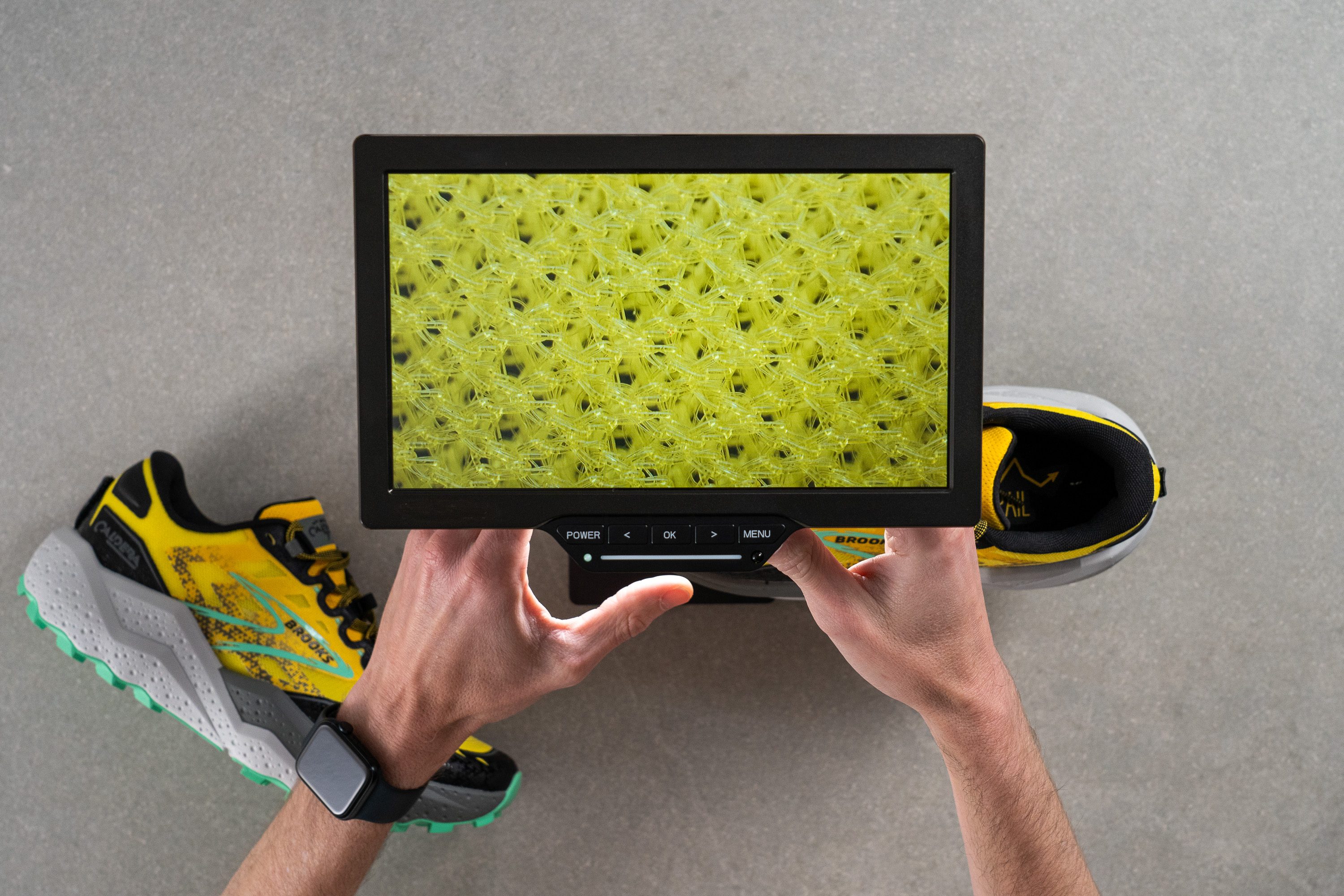
Initially, we didn't notice any ventilation holes, prompting a closer look under the microscope. To our delight, we uncovered hundreds of microscopic holes within the engineered mesh, designed to efficiently manage air and moisture.
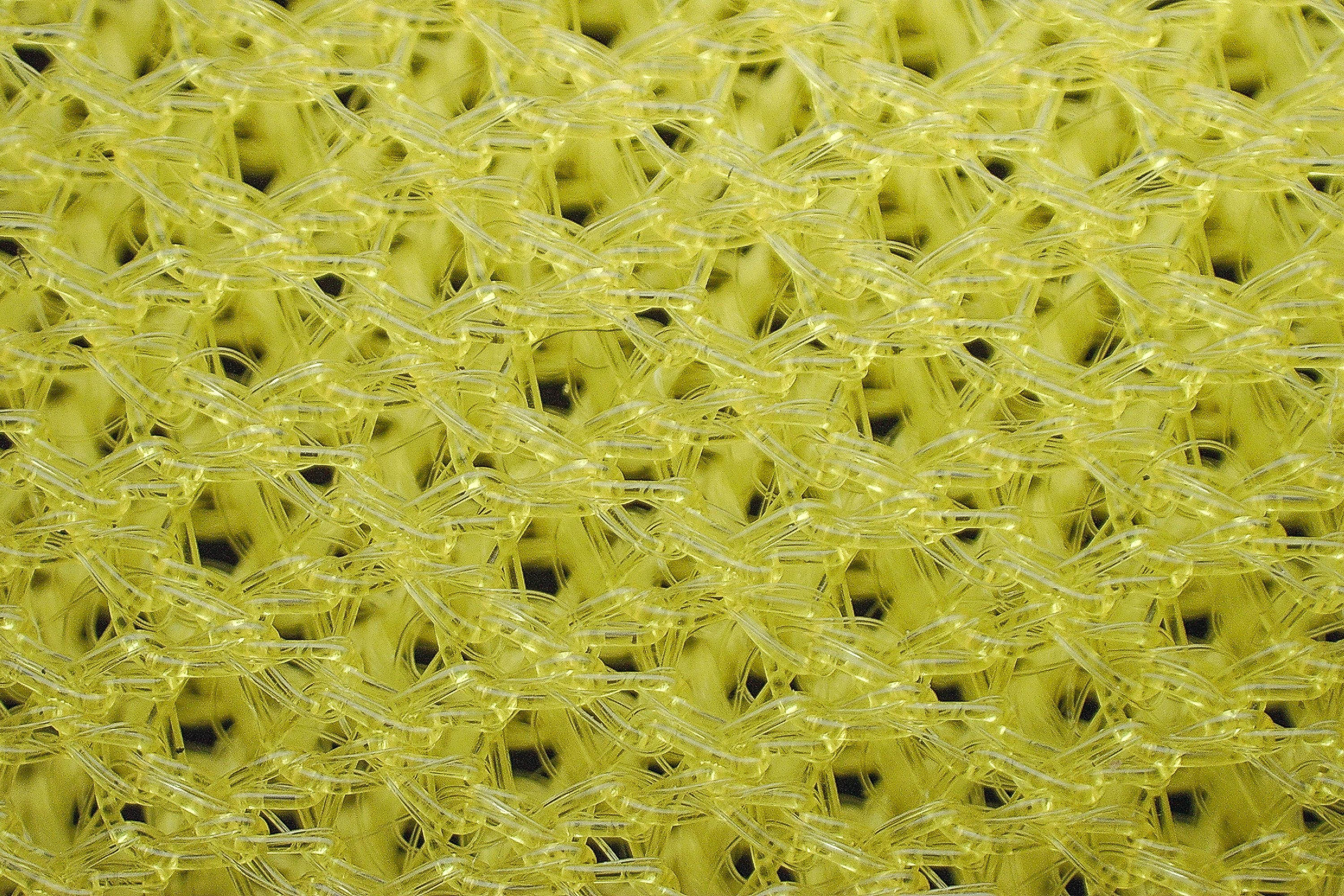
Although the mesh isn't particularly stretchy, it offers commendable comfort.
The midfoot and heel areas, while adequately padded, do not quite reach exceptional levels, probably due to weight concerns at Brooks HQ.
| Caldera 7 | 5 |
| Average | 3.2 |
Stability
Lateral stability test
The Brooks Caldera 7 has shed some stack height, yet it remains impressively tall for a trail shoe. This might suggest a risk of instability, yet, surprisingly, our experience was quite the contrary—we felt better-than-average support.
How is this possible? We attribute much of the stability to the substantial midsole sidewalls that adeptly channel the foot forward. However, there's more to the story—let's dive deeper.
Torsional rigidity
This shoe is remarkably inflexible—even boasting a central groove in the outsole—as we struggled considerably when attempting to twist it.
This rigidity led us to rate it a solid 4/5—yet it also helped us understand why it's not ideally suited for tackling complex, technical terrains. This lack of flexibility limits agility where nimble movements are crucial, and positions the shoe as a solid pick for easy trails.
| Caldera 7 | 4 |
| Average | 3.6 |
Heel counter stiffness
To enhance stability, Brooks maintained the same stiffness level (4/5) in the heel counter. This decision, while positive for stability, slightly compromises comfort.
| Caldera 7 | 4 |
| Average | 3 |
Midsole width - forefoot
In terms of stability, the standout feature of the Caldera 7 is its impressively wide midsole. We measured 118.6 mm in the forefoot, providing an expansive and stable landing platform that benefits midfoot and forefoot strikers.
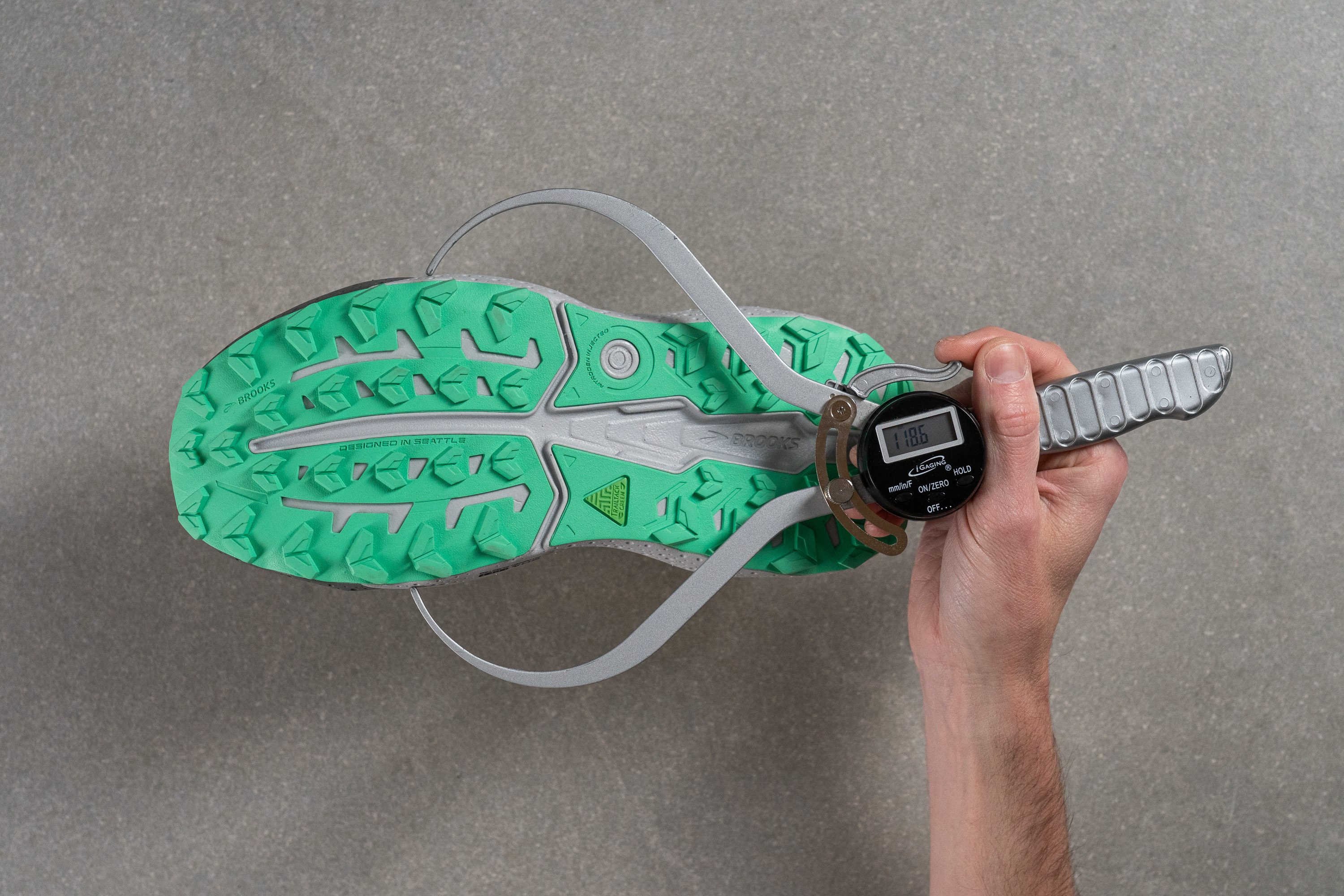
| Caldera 7 | 118.6 mm |
| Average | 112.8 mm |
Midsole width - heel
If you think the forefoot of the Caldera 7 is broad, the heel will astonish you. We measured it at an expansive 105.2 mm, marking it as one of the broadest heels we've encountered in trail running shoes, which dramatically enhances stability for rearfoot strikers.
However, we've noted a necessary compromise. Comparing the agility of an SUV to a sports car—the Caldera 7 obviously resembles the SUV, reducing its nimbleness around tight turns.
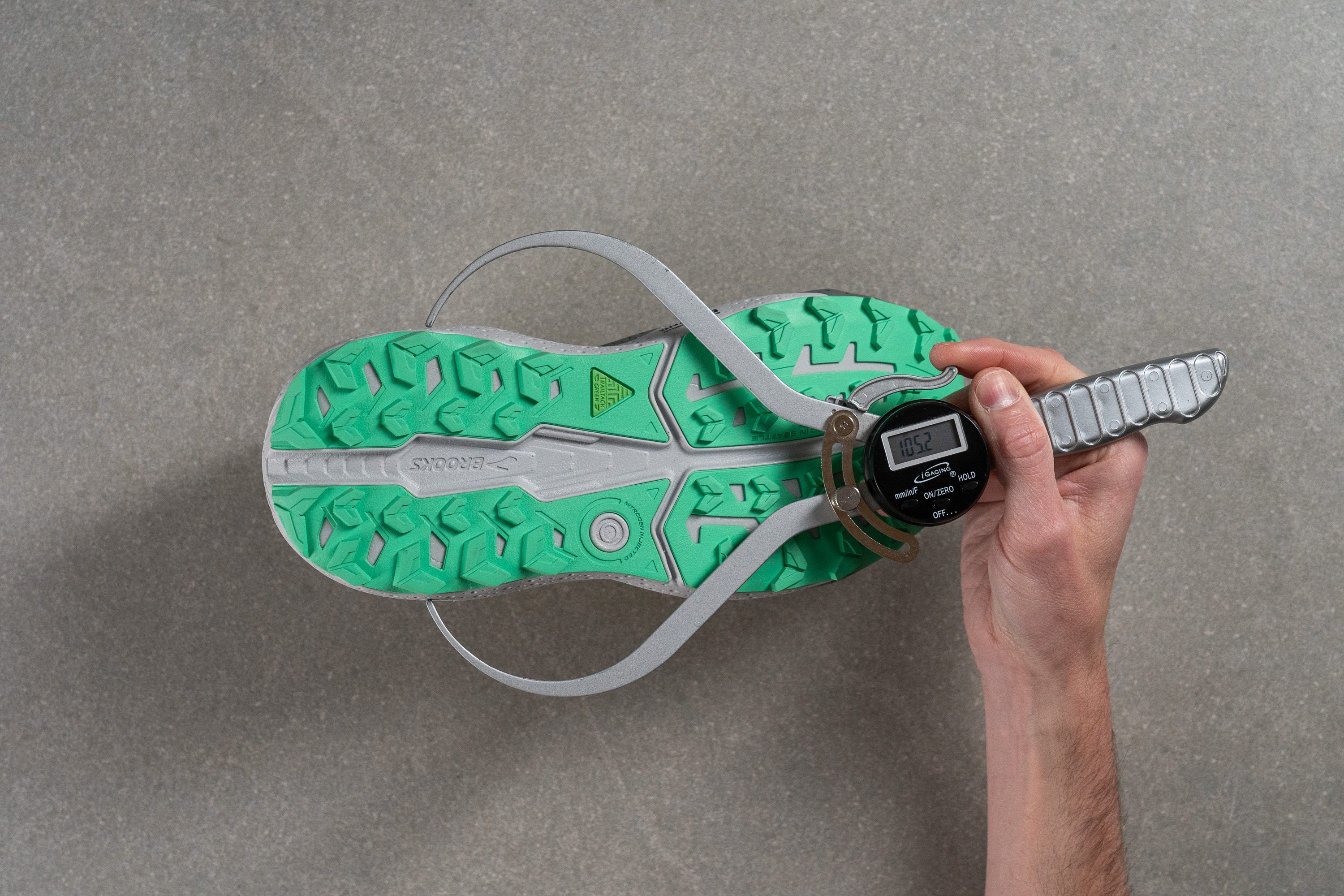
| Caldera 7 | 105.2 mm |
| Average | 89.8 mm |
Durability
Toebox durability
Boasting exceptional ventilation through its ultra-thin toebox, the Caldera 7 was screaming for our Dremel test.
At 5,000 RPM, the Dremel attacked the TPEE upper, yet the toebox showed impressive resilience, largely due to the tough overlays protecting it. This performance confirms that the Caldera 7 excels in providing both superior breathability and solid durability—a rare combination in trail shoes!
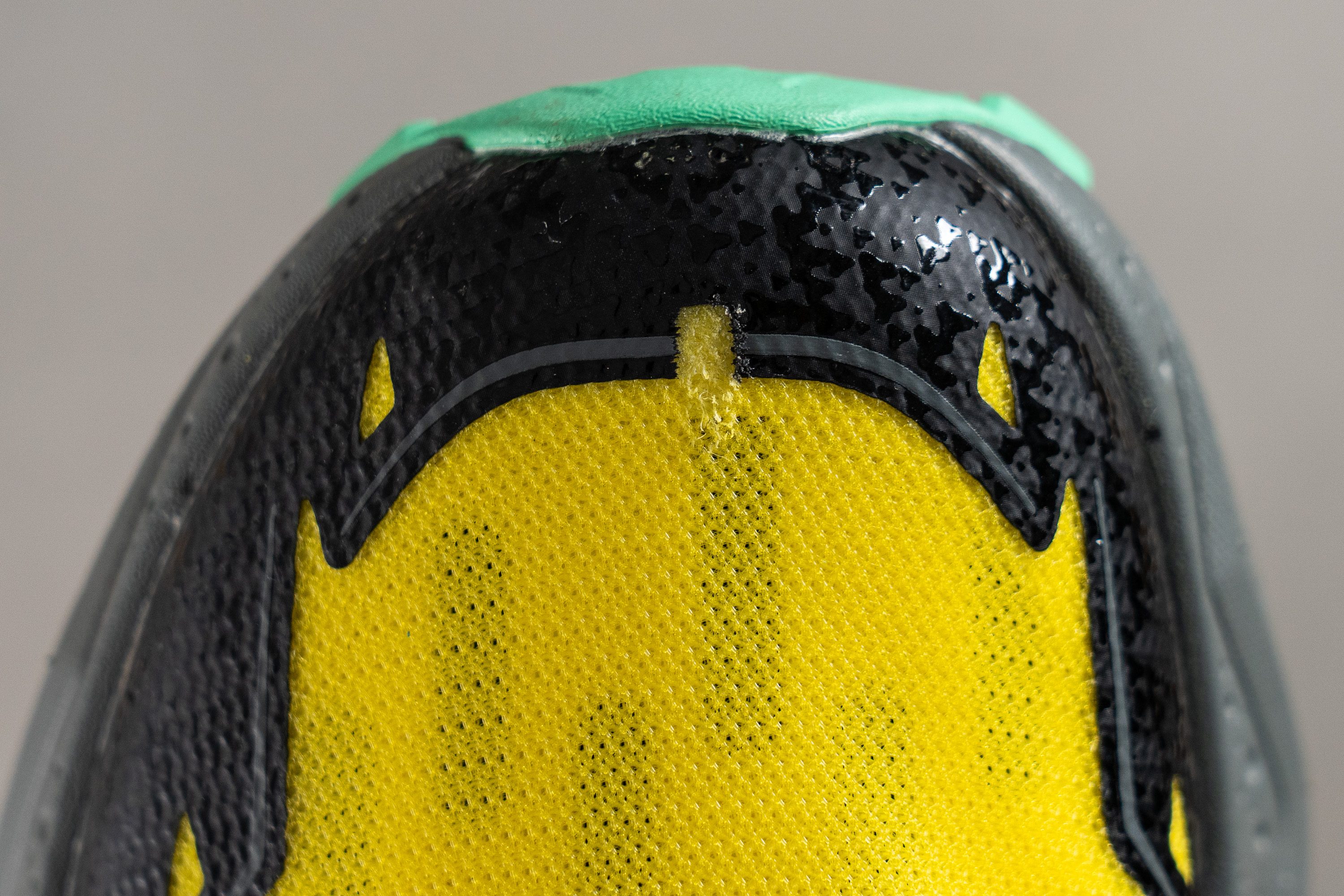
| Caldera 7 | 3 |
| Average | 3.1 |
Heel padding durability
Satisfied with the toebox durability, we turned our focus to the heel, hoping for equally impressive results.
To our delight, the outcome surpassed our expectations—after evaluating the damage, we awarded the Caldera 7 a robust 4/5 for heel durability.

| Caldera 7 | 4 |
| Average | 3 |
Outsole hardness
A crucial feature of any trail shoe is its outsole, which must provide a robust mix of durability and traction.

In our outsole hardness evaluation, we applied our Shore C durometer to the TrailTrack Green material and recorded a score of 90.4 HC. This score aligns with our experience on the trails—while the Caldera 7 offers decent grip, it doesn’t quite reach the heights of extraordinary performance.
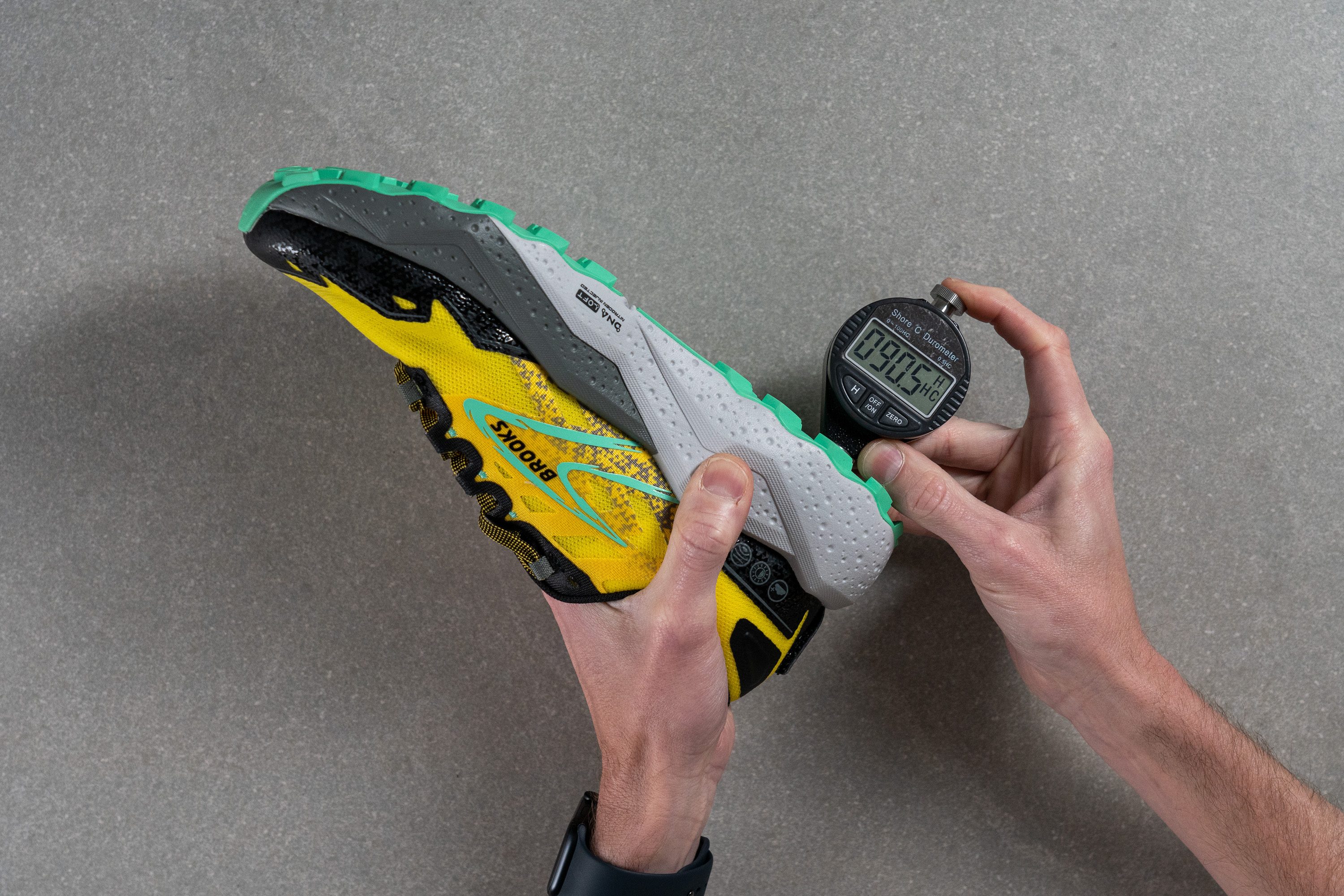
| Caldera 7 | 90.4 HC |
| Average | 85.8 HC |
Outsole durability
After our durometer recorded such high score, our anticipation grew to deploy the Dremel one last time in this lab review.
Unfortunately, our optimism was tempered when we measured the outsole with a tyre tread gauge and noted a disappointing 1.2-mm wear mark. While not alarmingly poor, this performance clearly demands enhancement for v8.
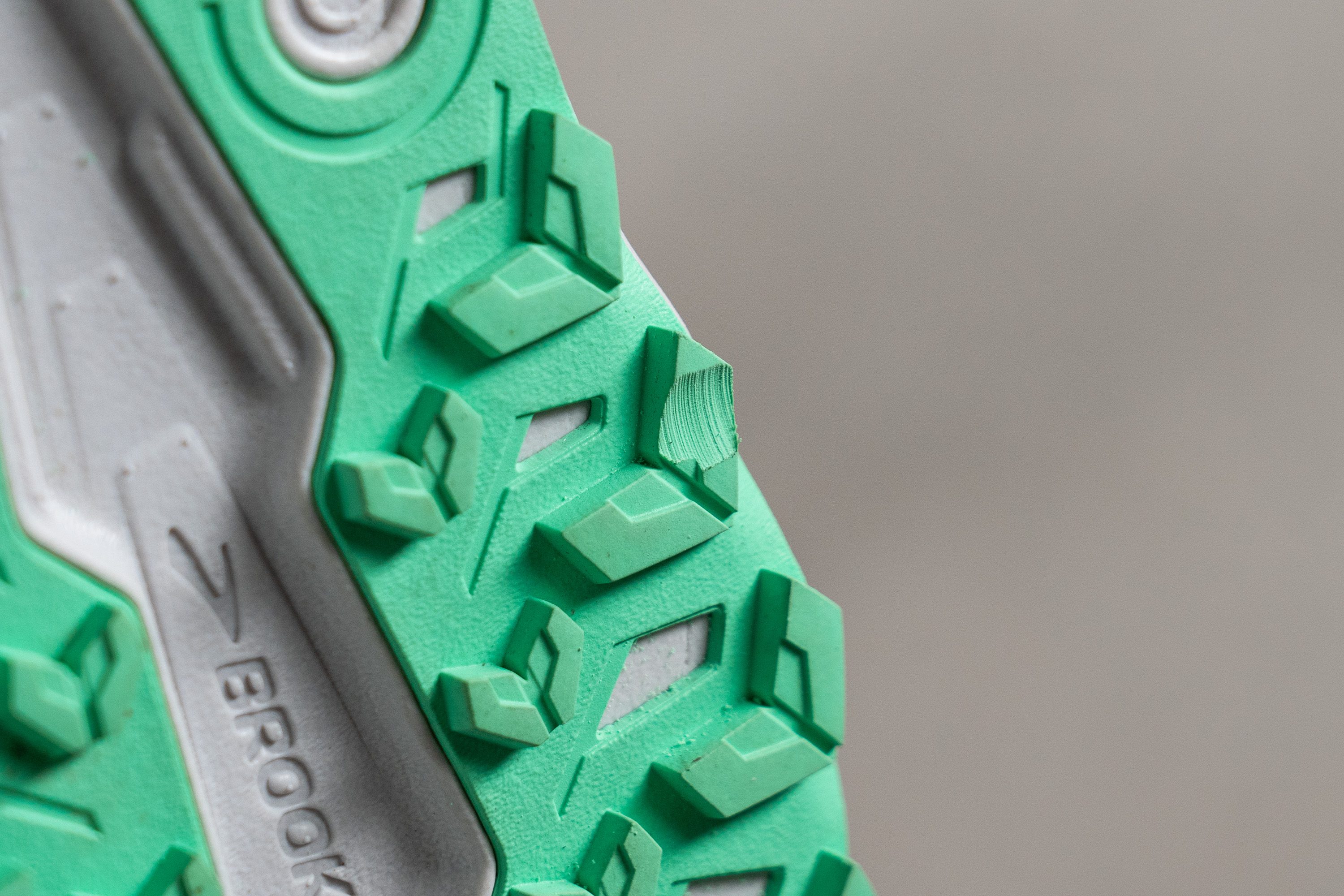
| Caldera 7 | 1.2 mm |
| Average | 0.9 mm |
Outsole thickness
We measured the outsole thickness at 2.0 mm—reasonable considering the heavier build of this shoe. However, it appears to us that Brooks might consider slimming this down in future models to reduce the overall weight.
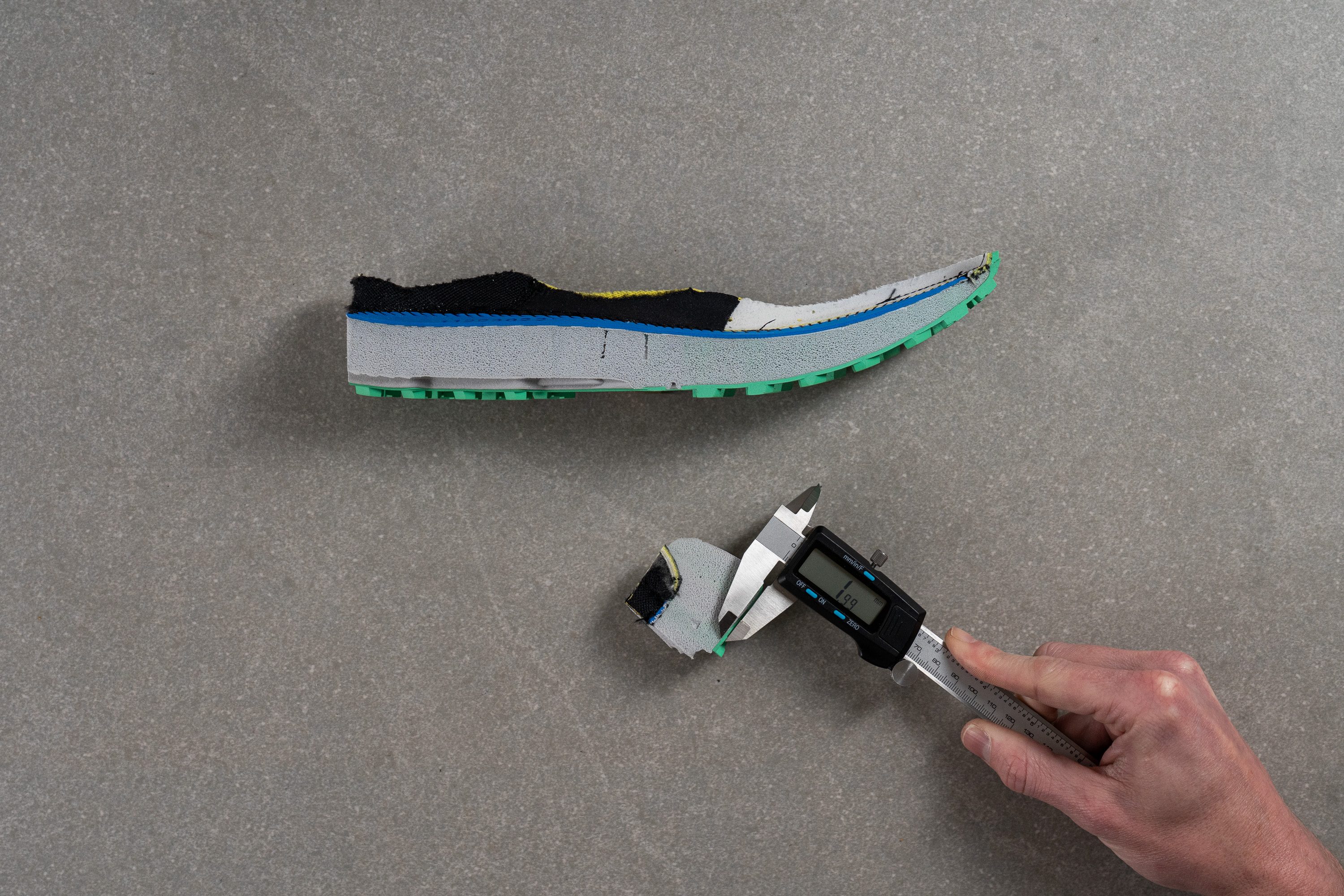
| Caldera 7 | 2.0 mm |
| Average | 2.2 mm |
Misc
Insole thickness
We discovered that the insole in the latest Caldera is 5.3 mm thick, slightly more than the 5.0 mm insole of the previous model. This additional thickness provides a bit more comfort underfoot.
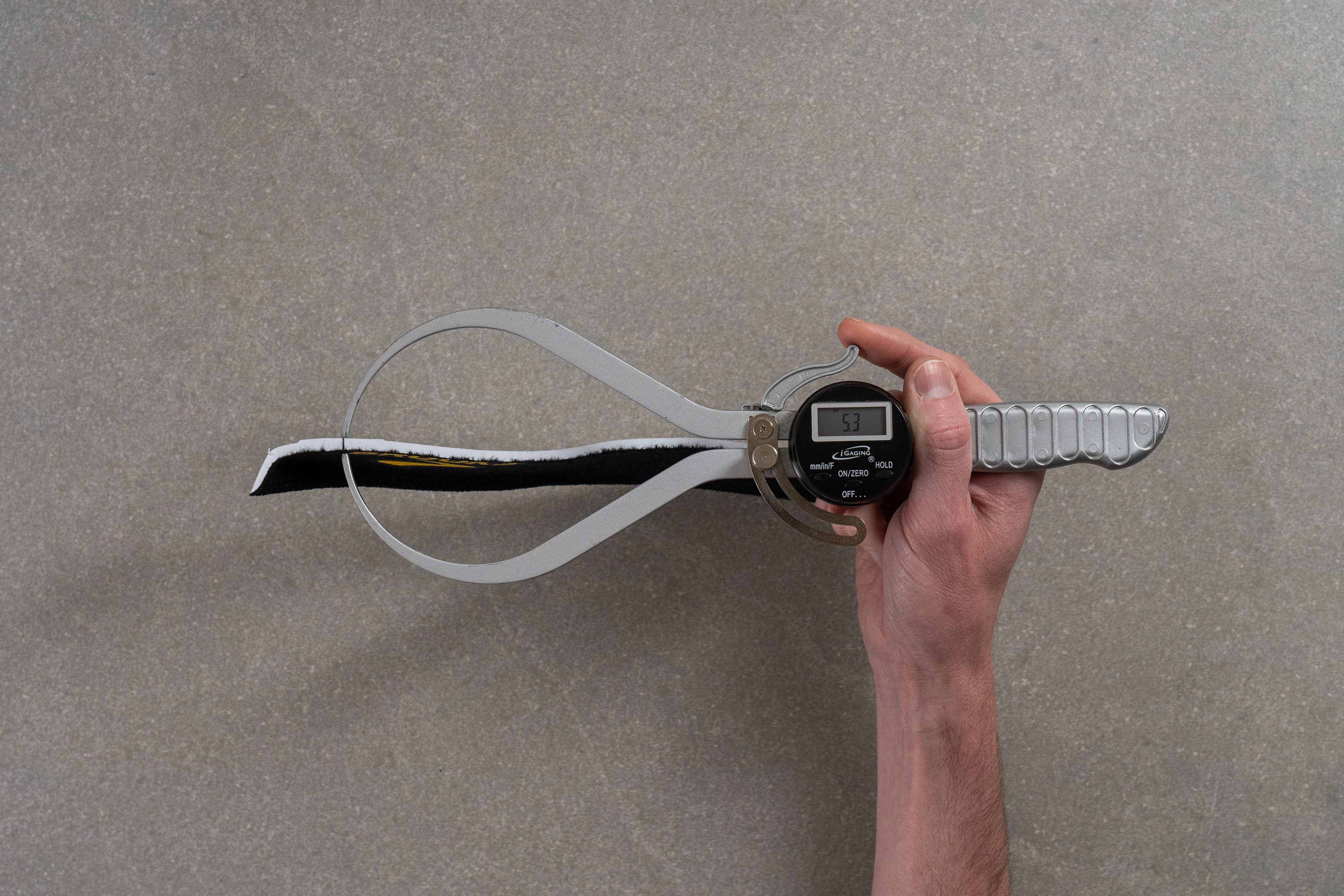
| Caldera 7 | 5.3 mm |
| Average | 4.7 mm |
Removable insole
The insole is standard and not glued, allowing you to easily swap it out with third-party footbeds right away. This flexibility is ideal for those who need customised orthotic support.
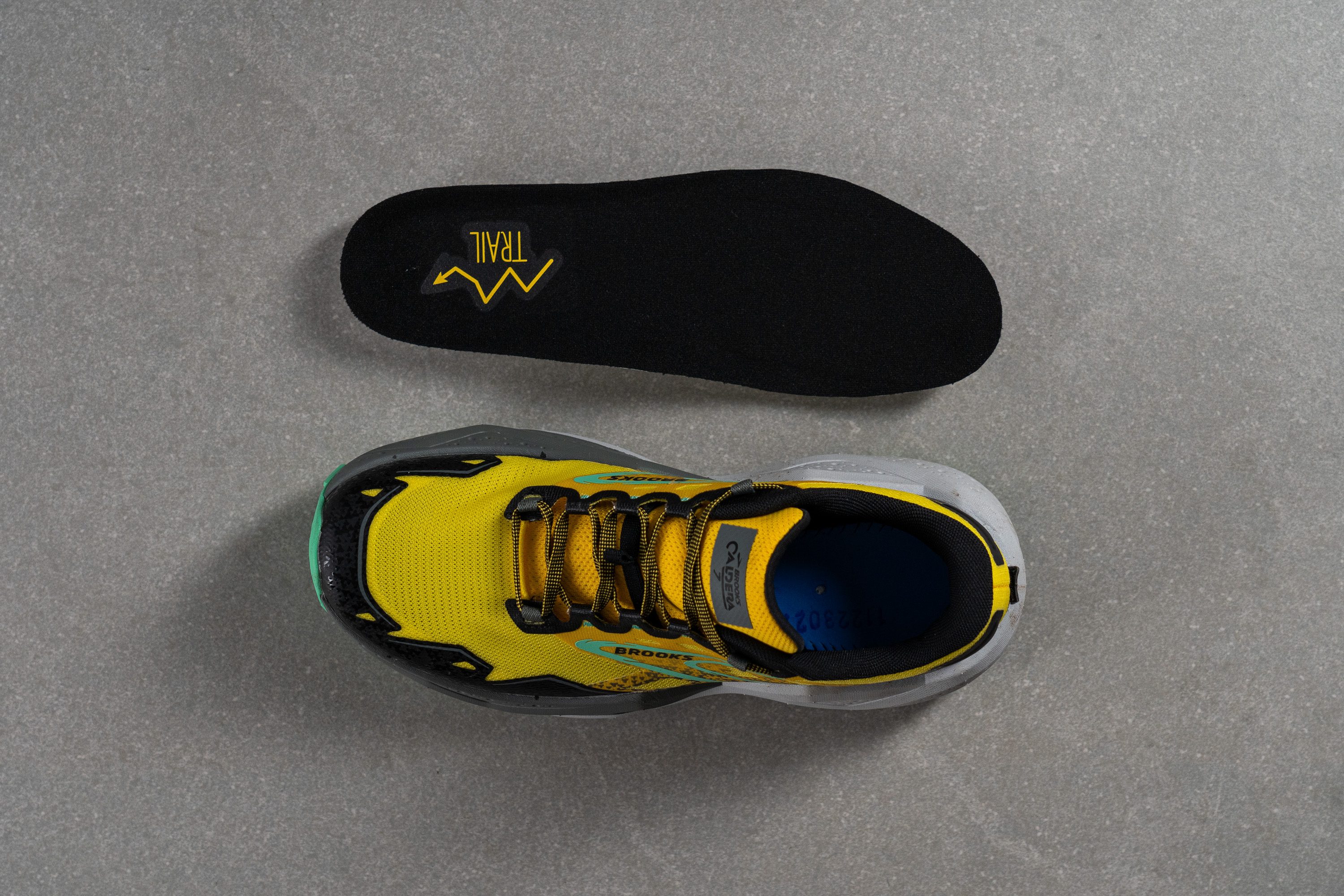
| Caldera 7 | Yes |
Midsole softness in cold (%)
After chilling the Caldera 7 in our freezer for just 20 minutes, we re-evaluated its softness. We were delighted to discover it had become only 20.2% firmer!
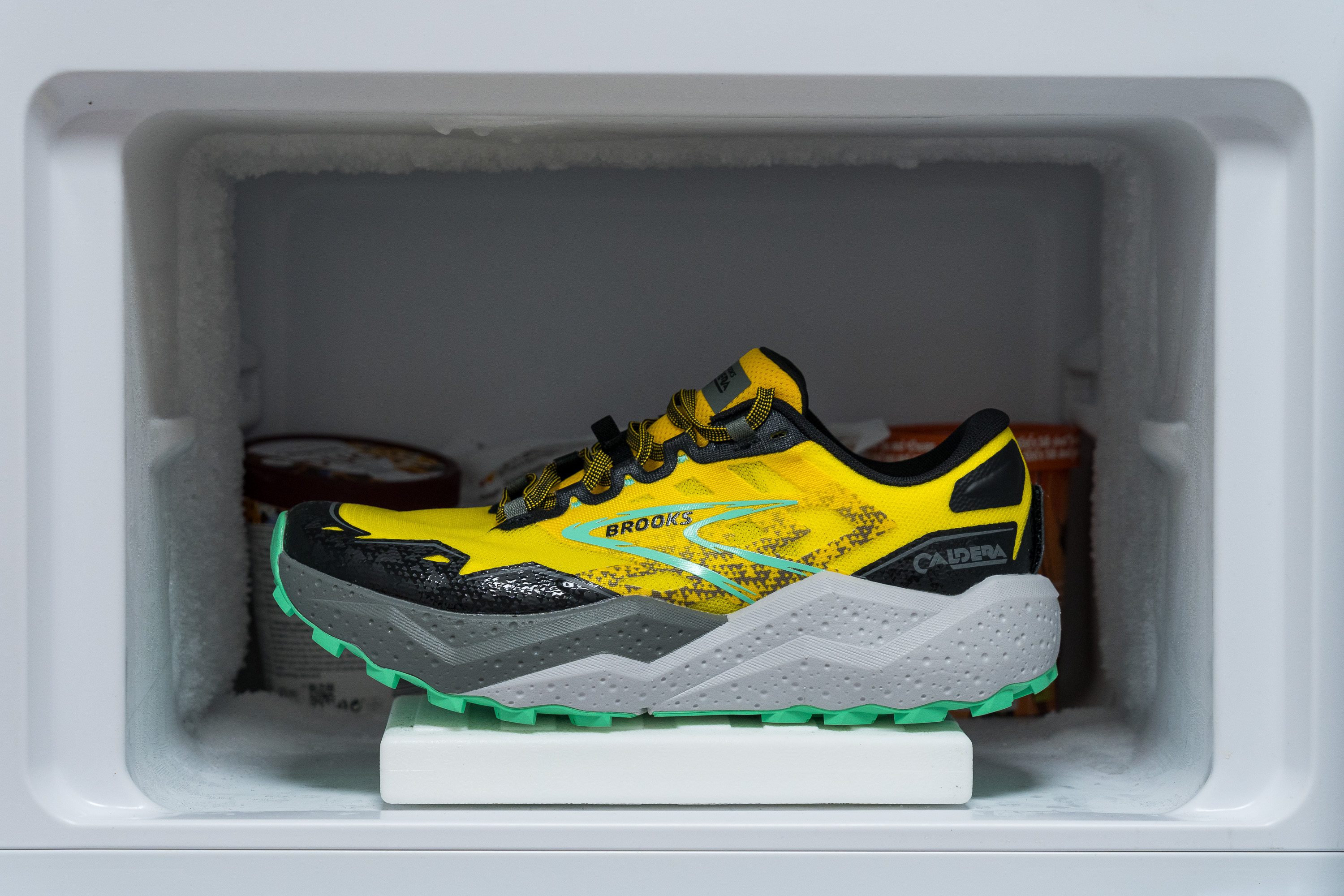
| Caldera 7 | 20% |
| Average | 26% |
Reflective elements
Unfortunately, the Caldera 7 lacks reflective features, which we always consider essential for trail shoes. This omission is a drawback for us, especially for runners who prioritise visibility at night.
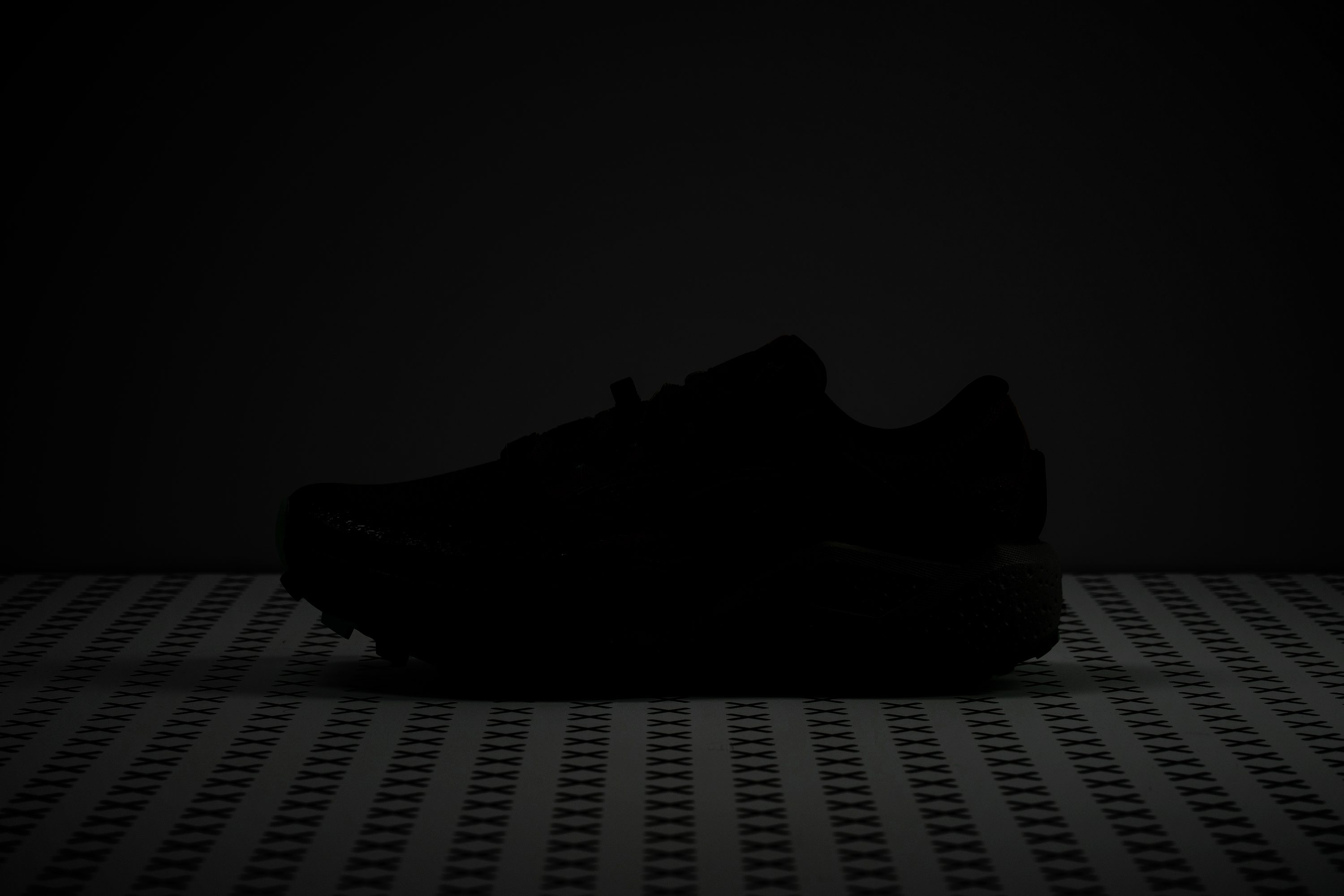
| Caldera 7 | No |
Tongue padding
As we mentioned earlier in our lab review, a major drawback of the Caldera 6 was its weight. Aware of this, Brooks made several minor adjustments to optimise the design without sacrificing cushioning. The tongue, now reduced to 3.8 mm, is a prime example of this effort.
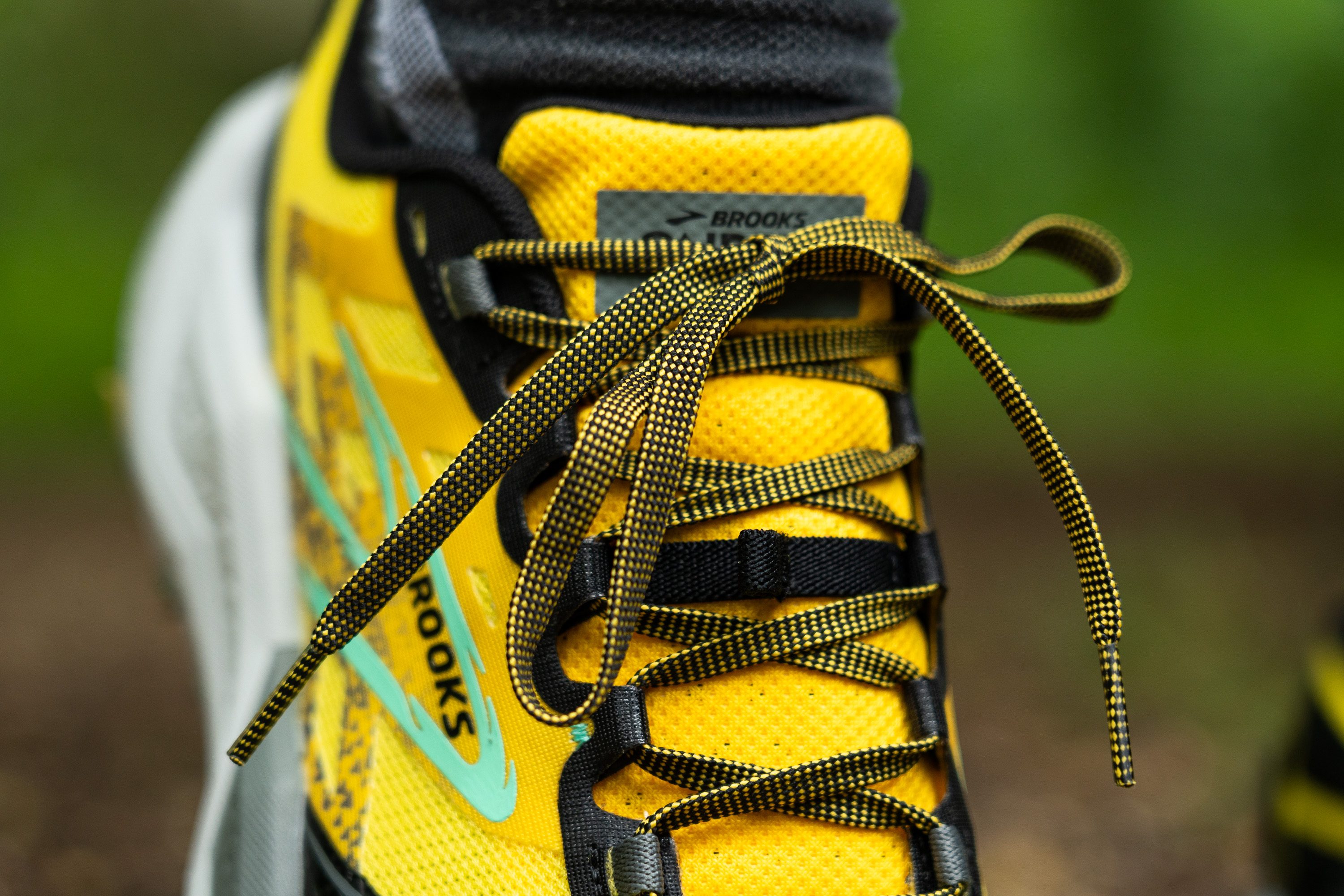
Is this change beneficial? For those who prefer a less padded tongue, it’s definitely a plus. However, runners who don’t mind a bit of extra weight for more comfort might prefer the thicker tongue of the Merrell Nova 3.
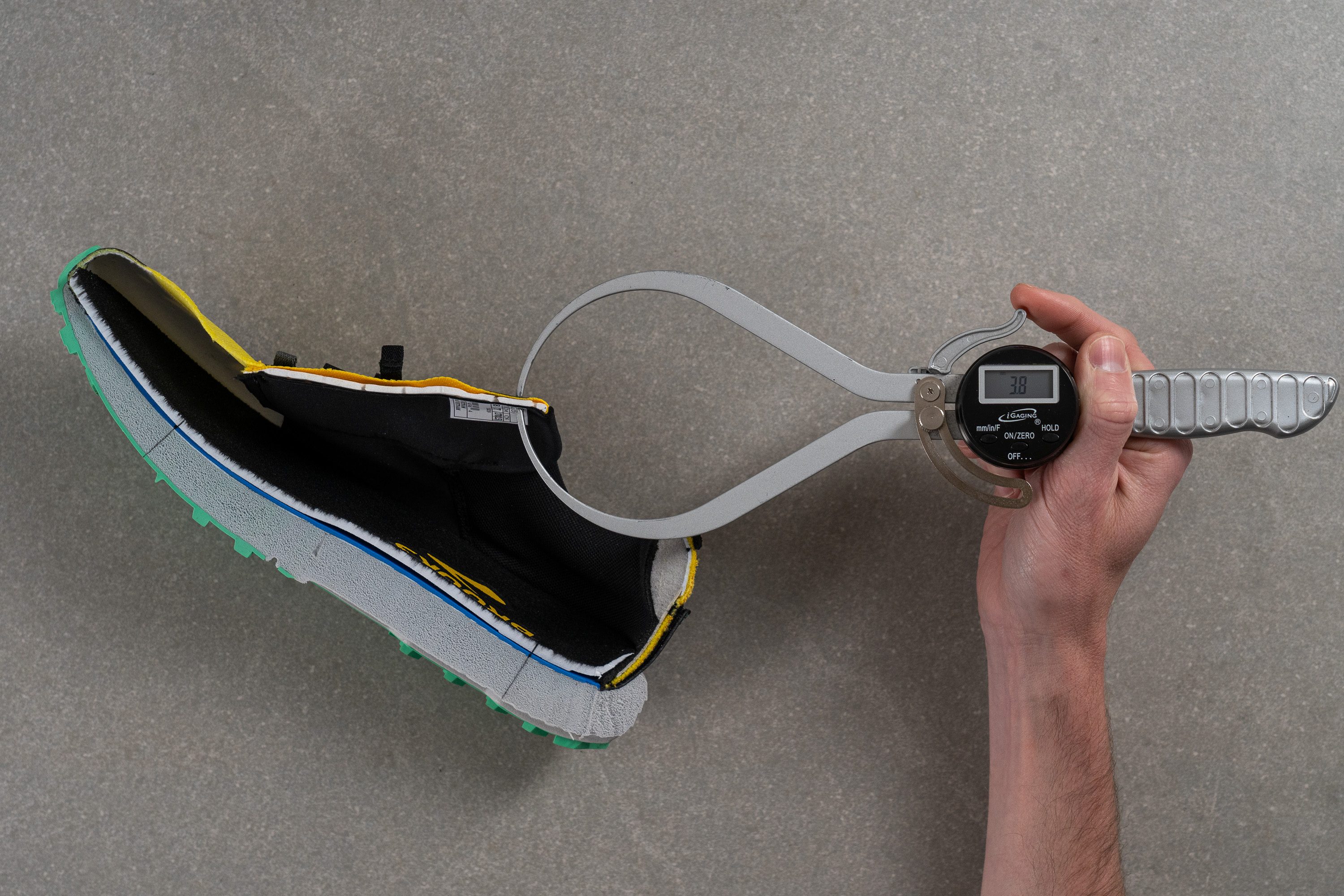
| Caldera 7 | 3.8 mm |
| Average | 6.4 mm |
Tongue: gusset type
We were delighted to discover a fully gusseted tongue in the Caldera 7, a feature we consider essential for any trail shoe. This design effectively keeps most debris out of the toebox and ensures the tongue stays firmly in place, preventing any side-to-side movement.
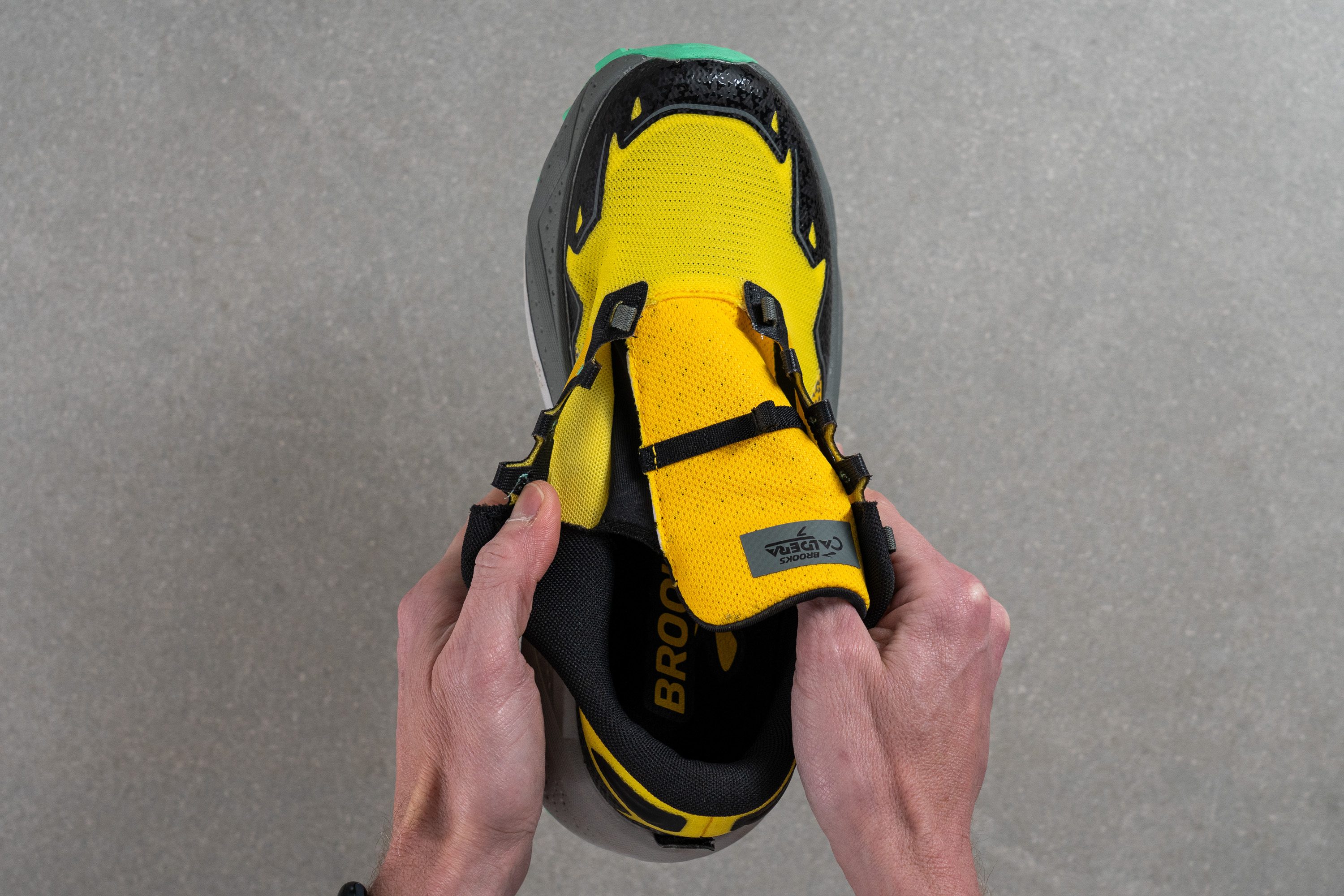
| Caldera 7 | Both sides (semi) |
Heel tab
Consistent with recent Brooks design trends, the Caldera 7 omits a heel tab.
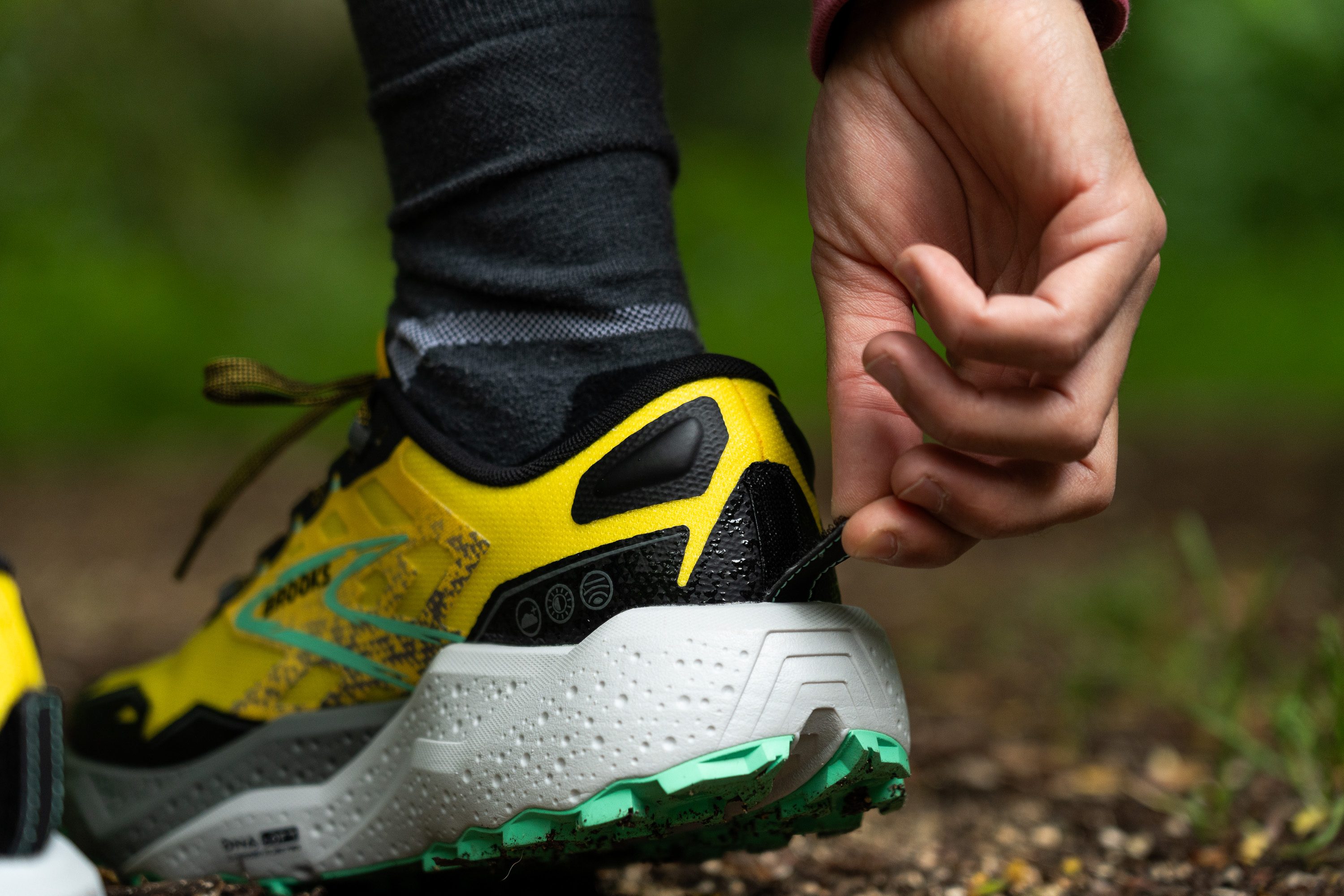
However, it includes a Velcro attachment point for securing ankle gaiters.
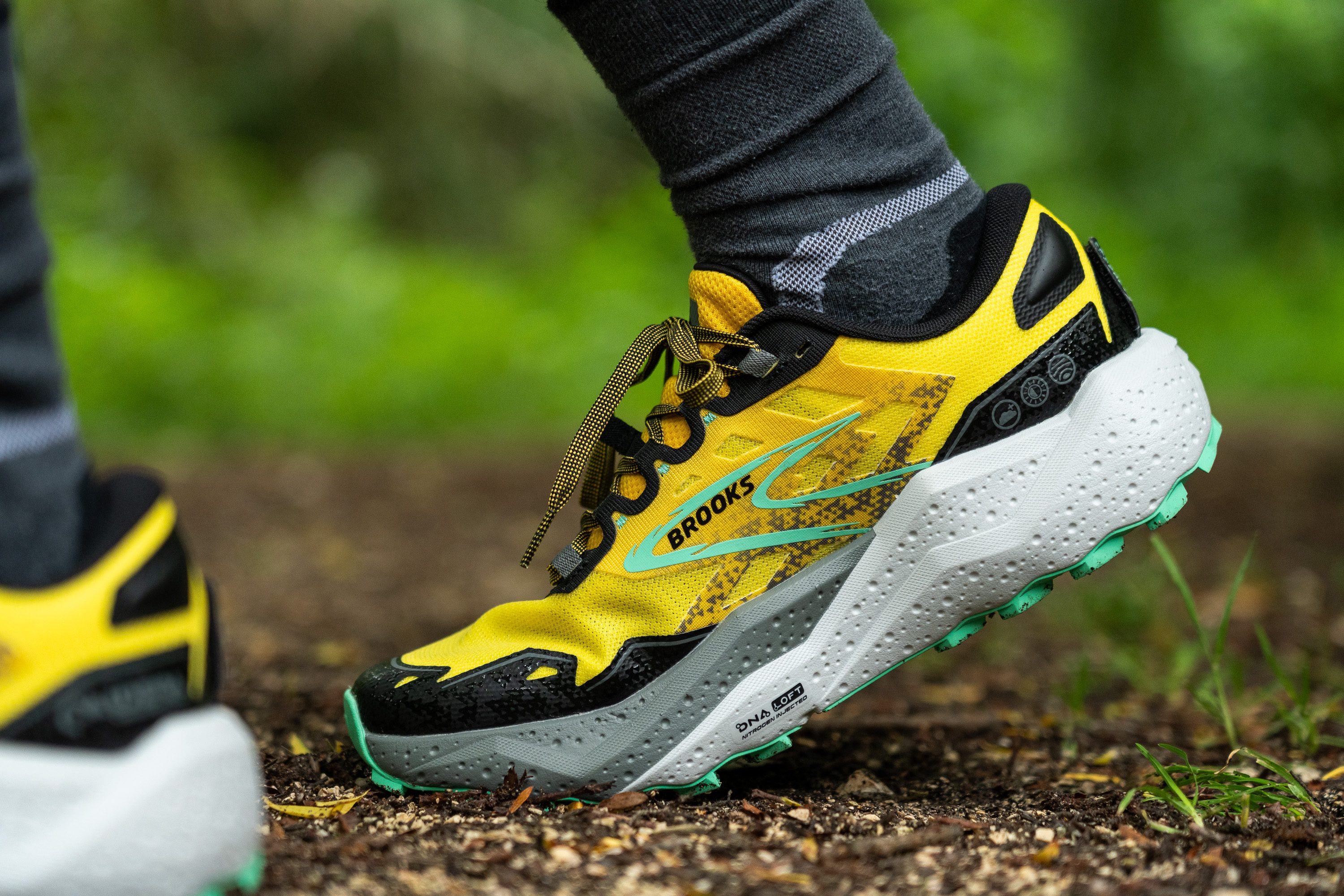
| Caldera 7 | None |

